1lumen selects and reviews products personally. We may earn affiliate commissions through our links, which help support our testing.
Olight Odiance review
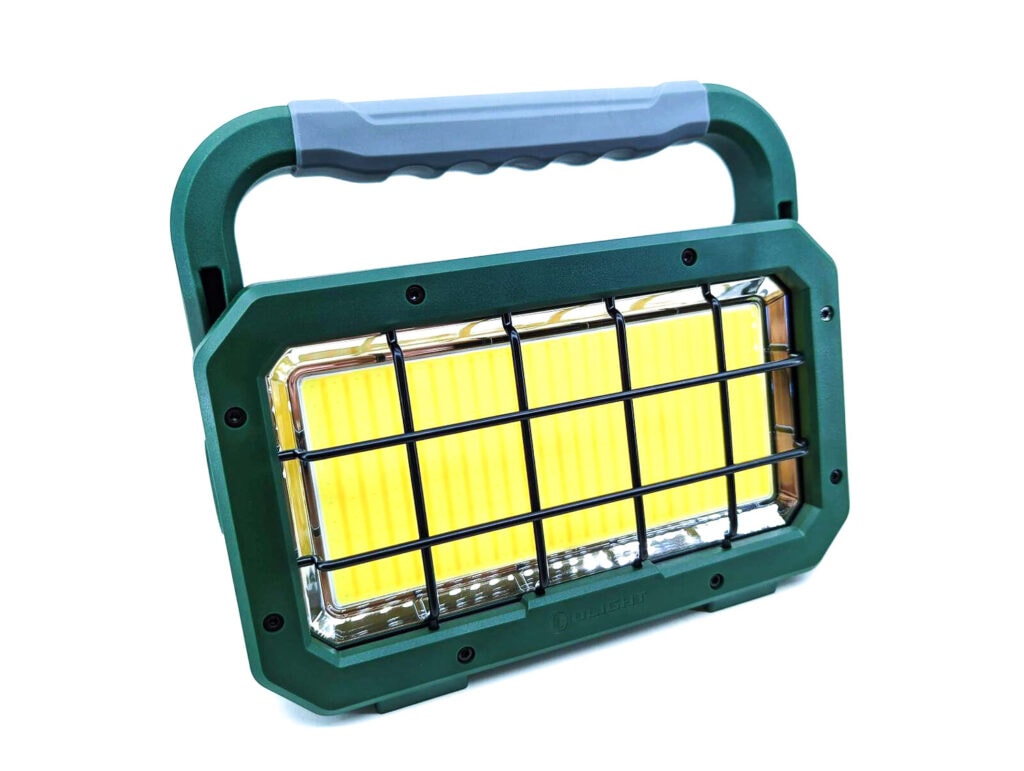
Olight Odiance specifications
| Brand & Model | Olight Odiance |
|---|---|
| Flashlight category | Work light |
| LED | COB |
| Max. output | 3,000 Lumens |
| Max. beam distance | 75 meters |
| Max. beam intensity | 1,500 cd |
| Battery config. | Built-in |
| Onboard charging | USB-C |
| Modes | Variable |
| Blinkies | N/A |
| Waterproof | IPX8 |
| Review publication date | September 2022 |
Introduction:
Olight has a pretty broad selection of lights. They make some great keychain lights such as the i3E EOS and the i1R 2 Pro. Olight also has EDC lights like the Baton series. But that’s not all… gun lights, tactical lights, high-power lights, general lamps/lanterns, and now branching out into things like knives and pens. For the most part, if it needs to be lit up, Olight has you covered. One of the things I love most about Olight is their attention to detail. Quality is generally fantastic, anodizing and machining are great… they just know how to make a solid product.
This particular model – the Olight Odiance – seems like something entirely new for Olight. It’s a full-on portable work light! And I don’t mean just a beefy right-angle light like the Perun 2 that can be handy for task lighting. The Odiance has a large built-in battery pack, a remote, carrying handle with tripod mount, and thousands of floody lumens that can be adjusted between warm white and cool white… cool, right?
Package quality.
The packaging of the Odiance is pretty typical of Olight. It consists of sturdy white cardboard with a clean design – an image of the light on the front. The rear is adorned with a drawing of the Odiance and highlights of the controls and features. In the box was:
- Olight Odiance
- Remote control
- Charging cable
- Manual
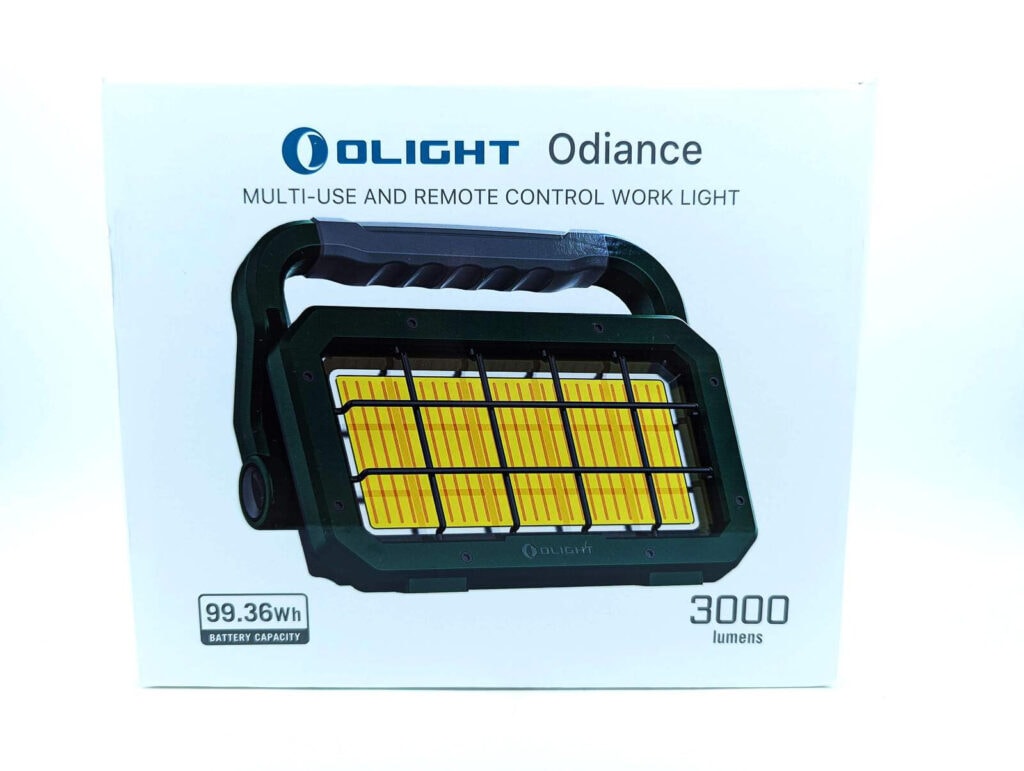
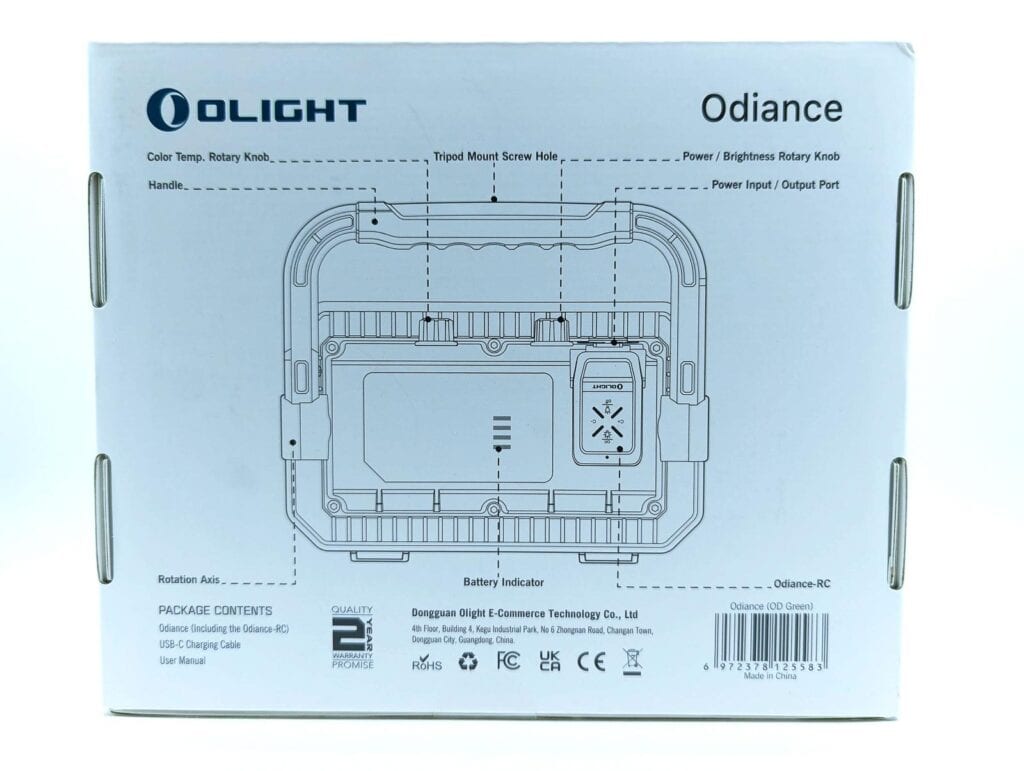
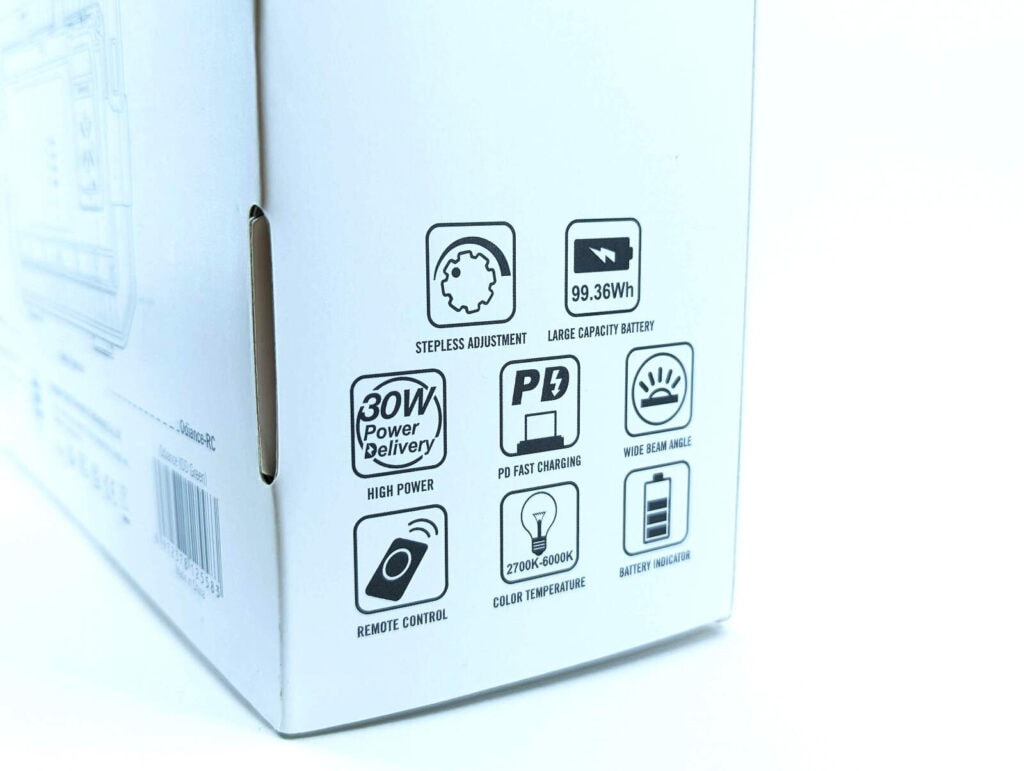
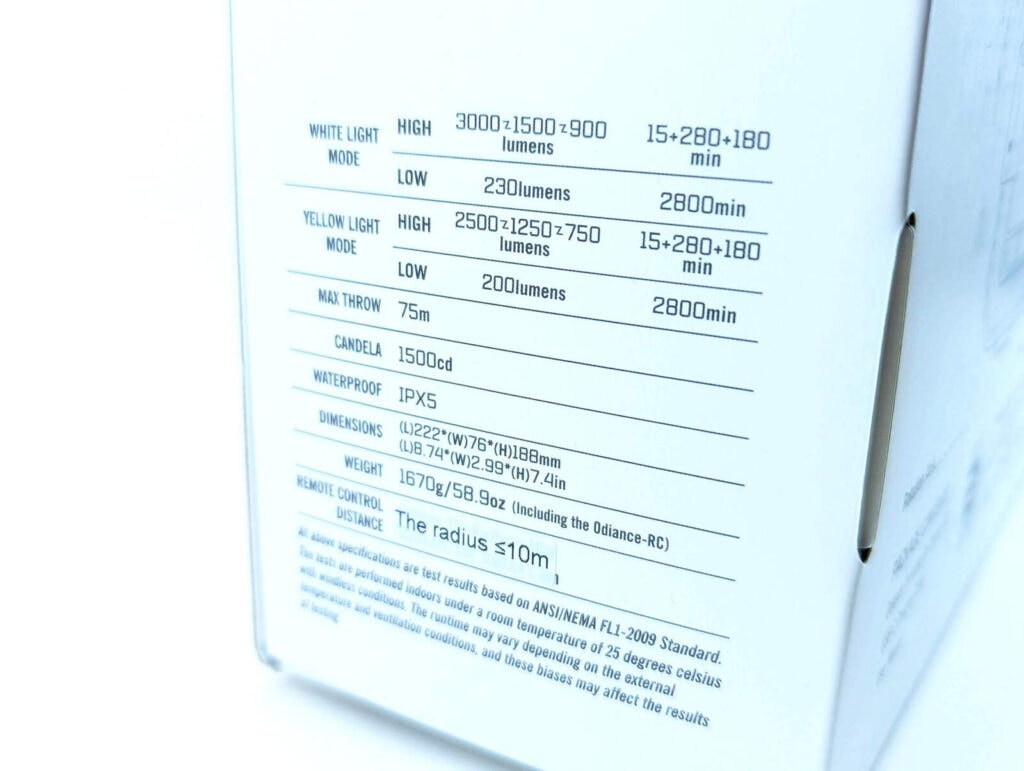
Flashlight in use
When I first picked up the Olight Odiance, my reaction was “woah, that’s hefty!” It certainly isn’t a lightweight device, owing mostly to the 99.36 watt-hour battery pack inside. Thankfully, it’s still easy to tote around because of the large carry handle. The handle doubles as a kickstand, allowing you to set it on a flat surface but still position it at different angles. There’s also a convenient tripod hole built into the handle, which again allows you to easily adjust the angle by moving the handle. The tripod mount isn’t something I would be too rough with – it looks like a press-fit connector set into a plastic (polycarbonate?) handle. It works – I would say just don’t get crazy with it.
On the backside of the Odiance are two rotating knobs for controlling the light. One knob controls on-off and brightness. There’s an audible click as you twist the knob away from the Off position and the light ramps up in brightness as you continue to rotate it clockwise. The other knob is used for controlling the color temperature of the light, which is said to be variable in 10 steps between 2700K and 6000K. The CCT knob does not have any end stops, it can continuously rotate.
In addition to the control knobs, Olight provides a handy little remote control that’s about the size of a vehicle remote. The remote allows for on-off control, brightness adjustments, and CCT adjustments. The remote slides into a slot on the back of the Odiance’s housing and is held in place by both a little bit of friction and some magnetic force.
The Odiance is right at home in the garage, backyard, campsite, and depending on your situation, perhaps construction site. It lights up a large area for a long time, which is really useful in these situations. I currently have 2 other work lights in my garage, but if I’m being honest with myself, I rarely use them because I don’t like dragging the power cord around. That sounds a bit lazy, and maybe it is. But I could see using Odiance a lot more often because all I would have to do is turn it on and point it at my task (usually, a vehicle).
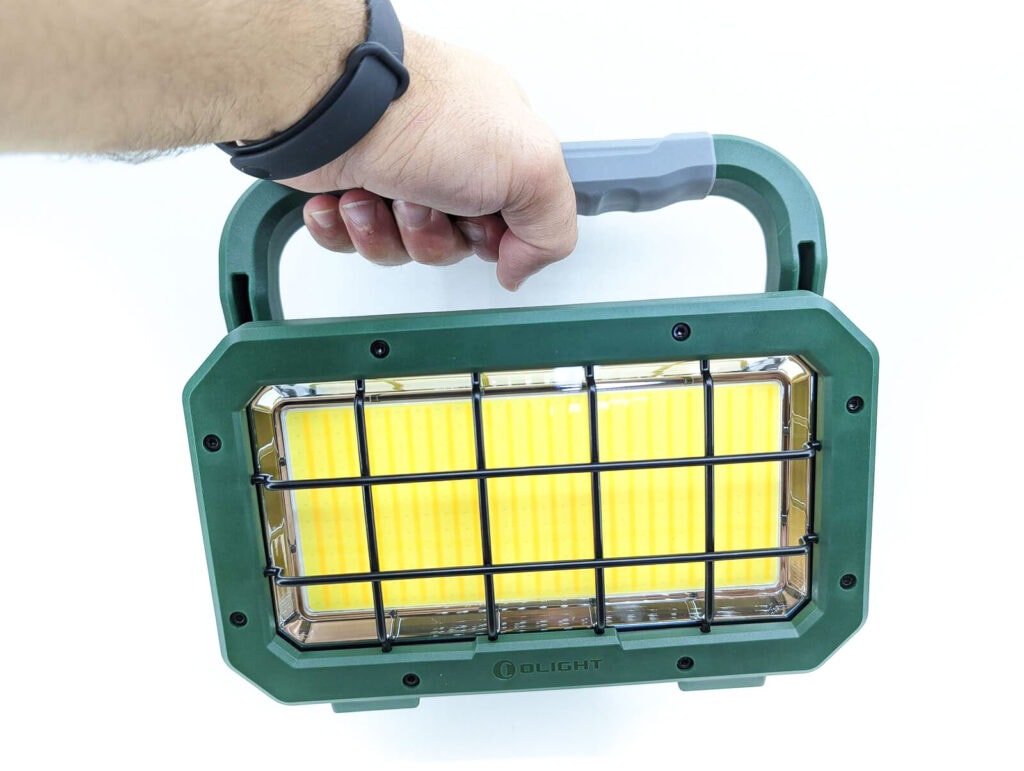
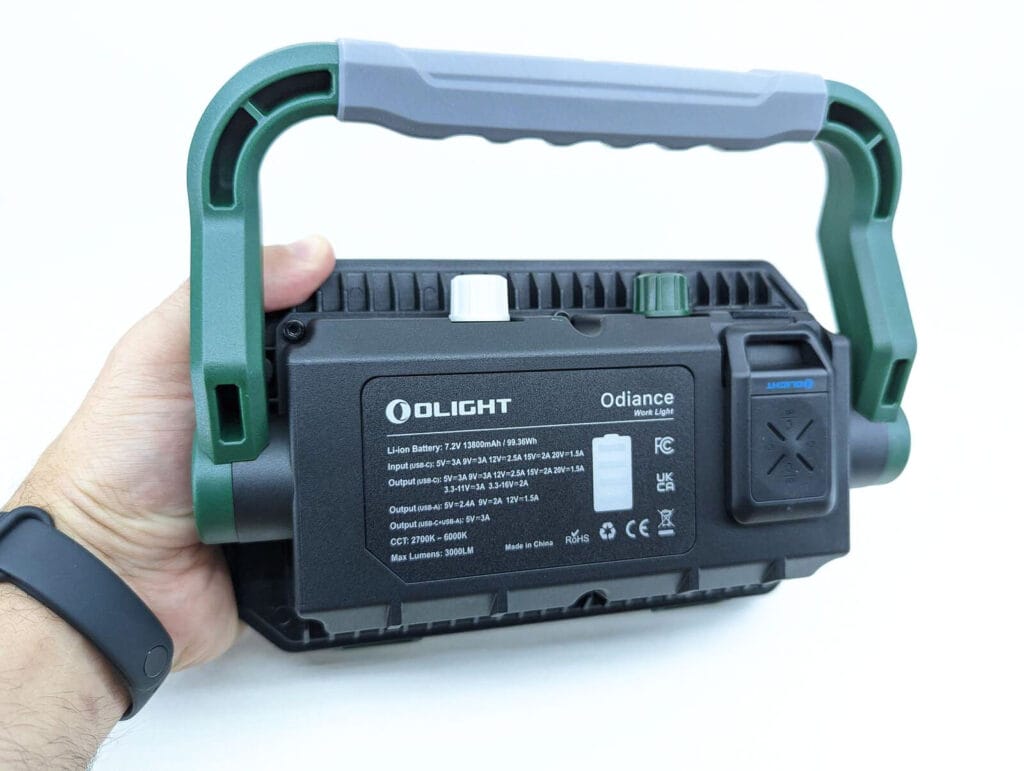
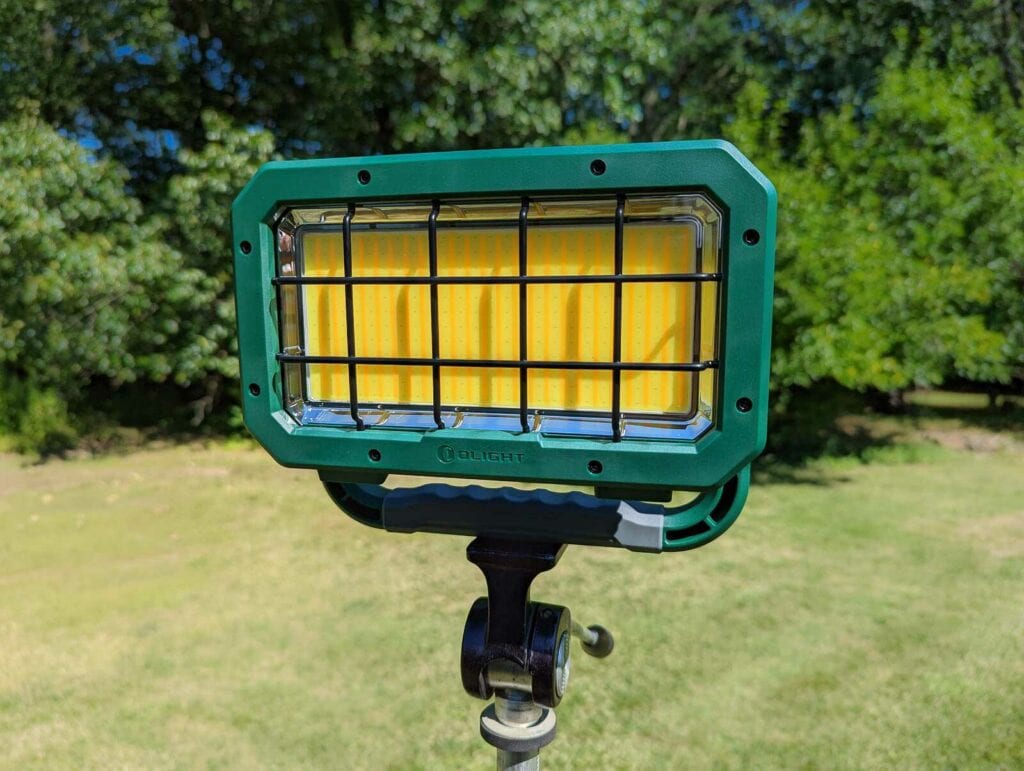
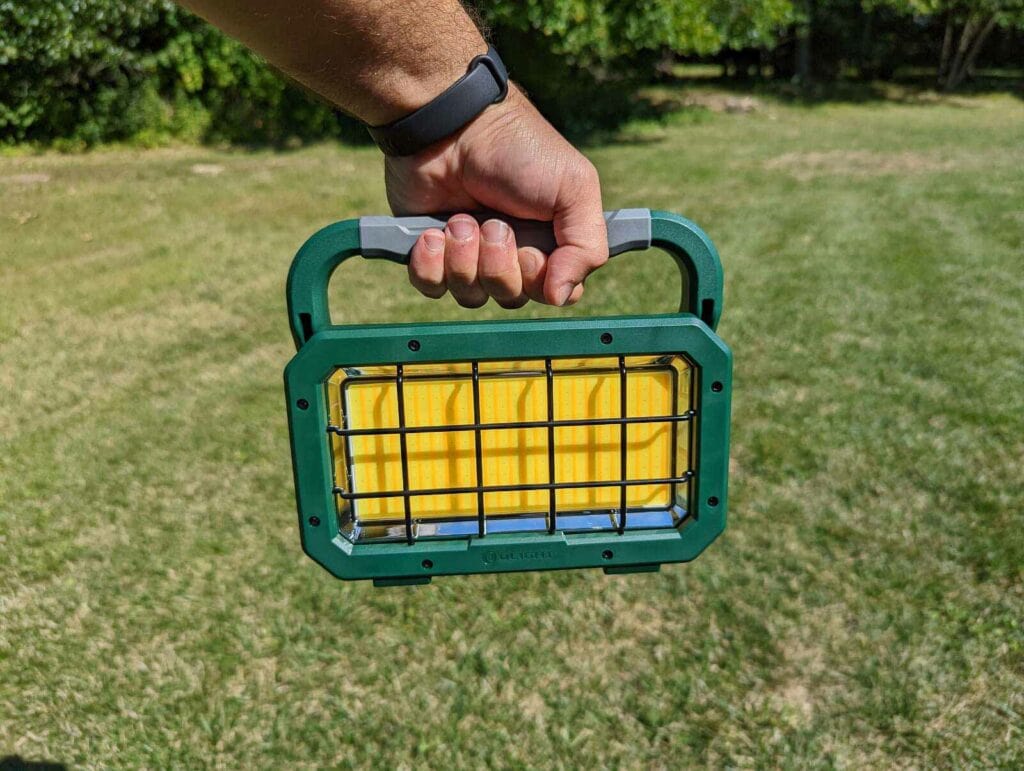
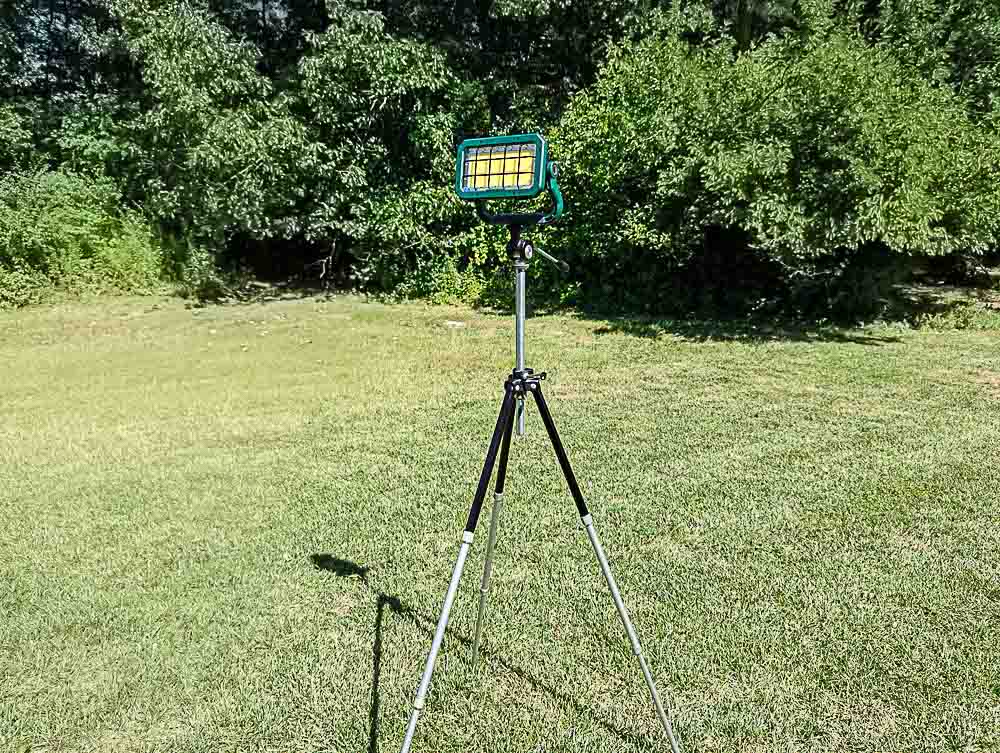
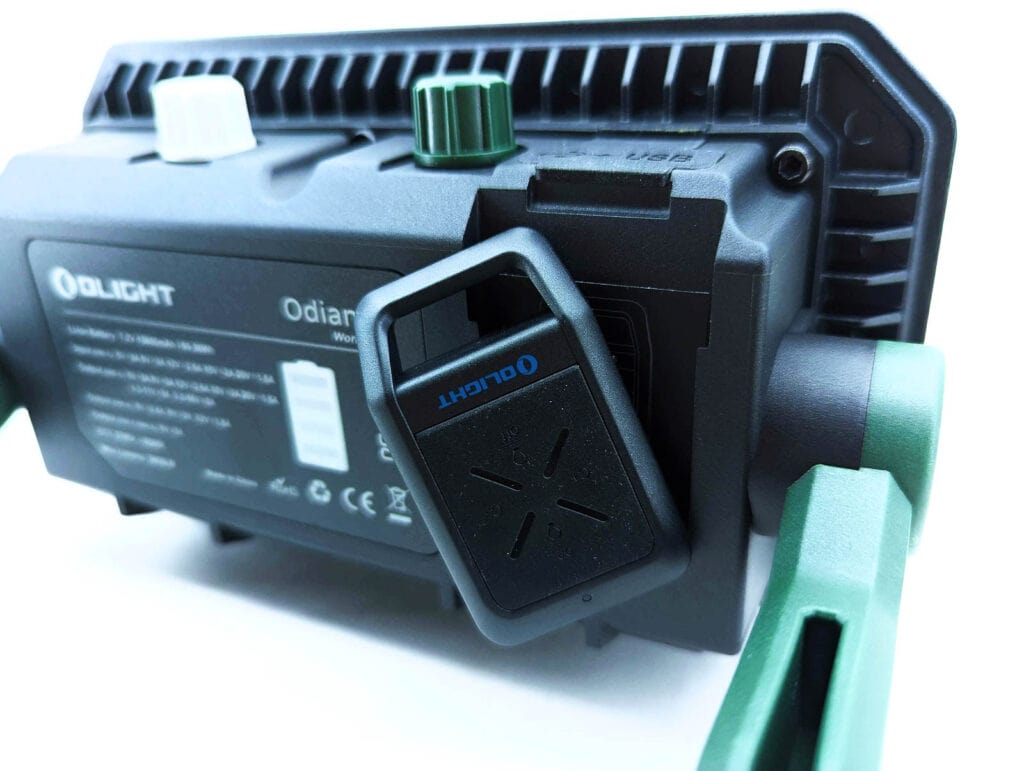
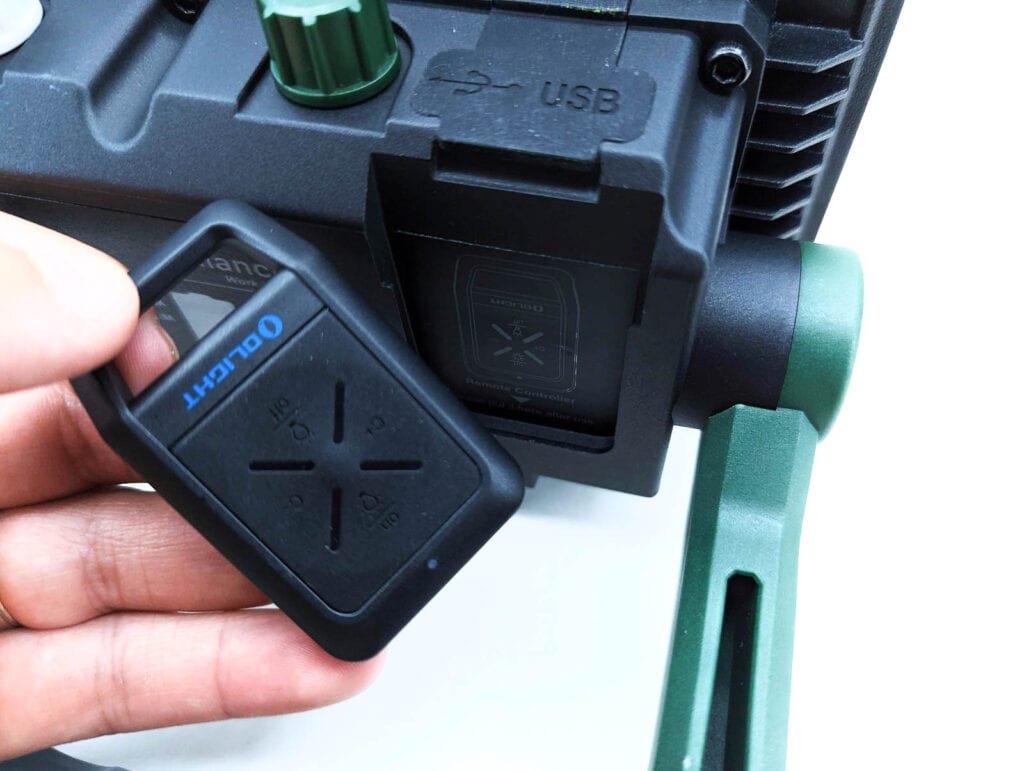
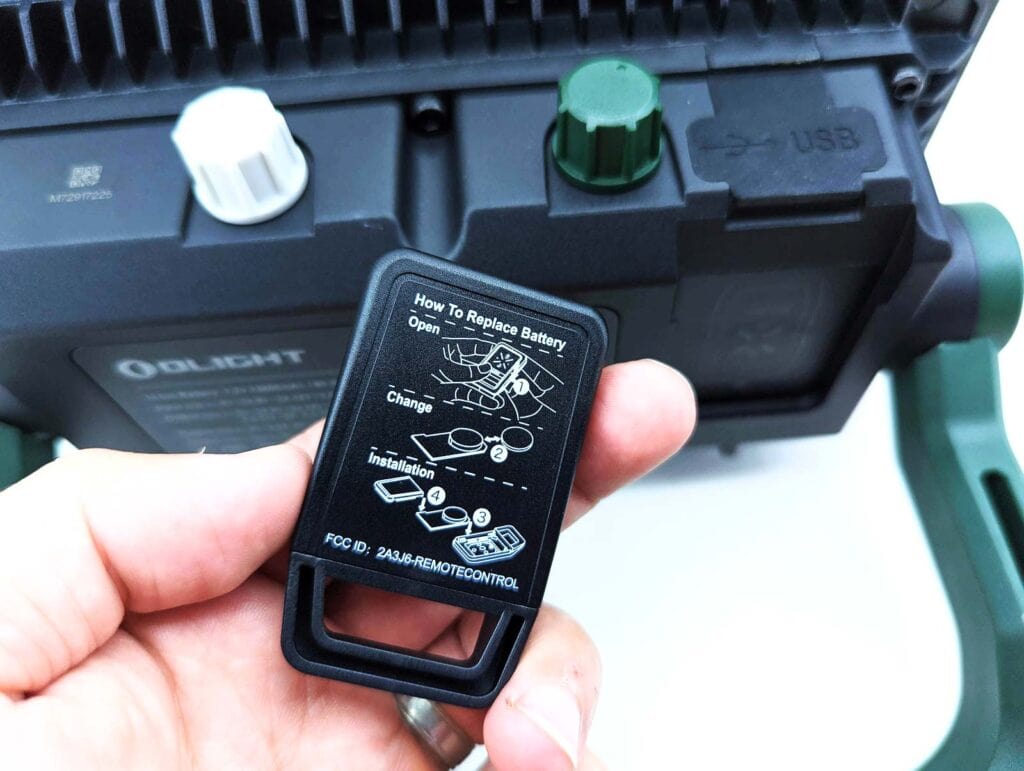
Build Quality, and Warranty
Olight says the Odiance is constructed from Aluminum and PC (polycarbonate). The rear housing, which has some heatsink fins for cooling, is likely the aluminum part. A lot of the rest of the light (front bezel, handle) appear to be polycarbonate components. While the handle seems plenty strong for most use cases, I probably wouldn’t trust it at an industrial construction where things may take a bit more abuse than in most other environments.
The overall construction of the Odiance, as I would expect from Olight, is nicely done. Everything seems well put together and solid.
Warranty:
- Within 30 days of purchase: Contact the original seller for repair or replacement.
- Within 2 years of purchase: Contact Olight for repair or replacement.
- Odiance-RC: One year
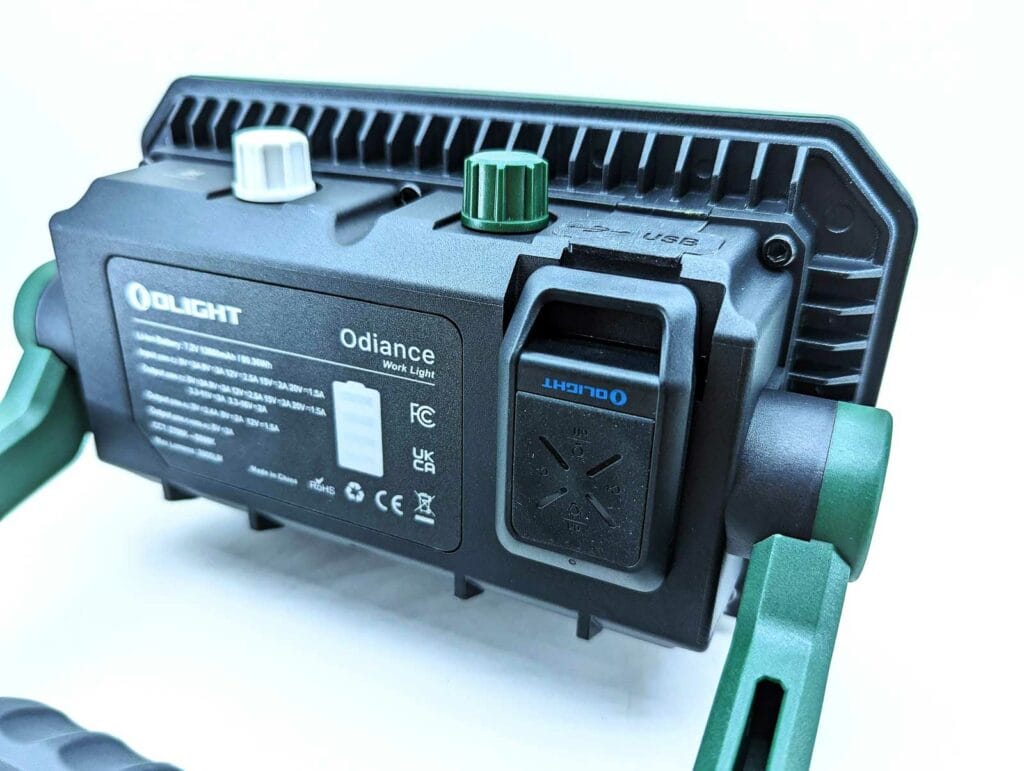
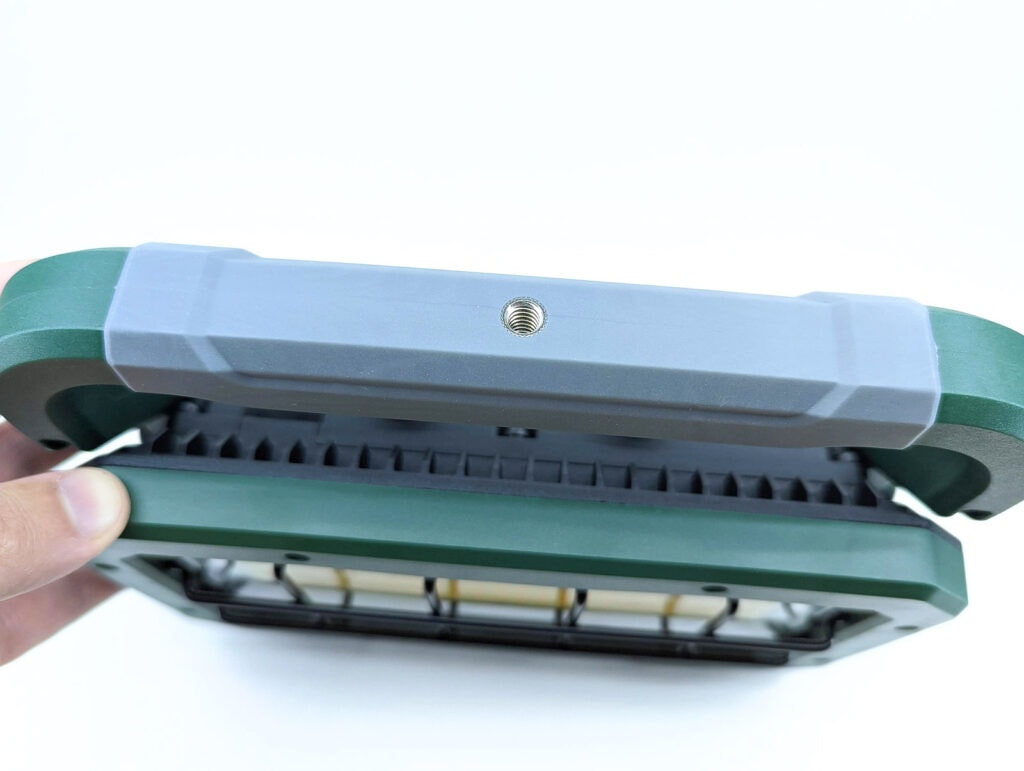
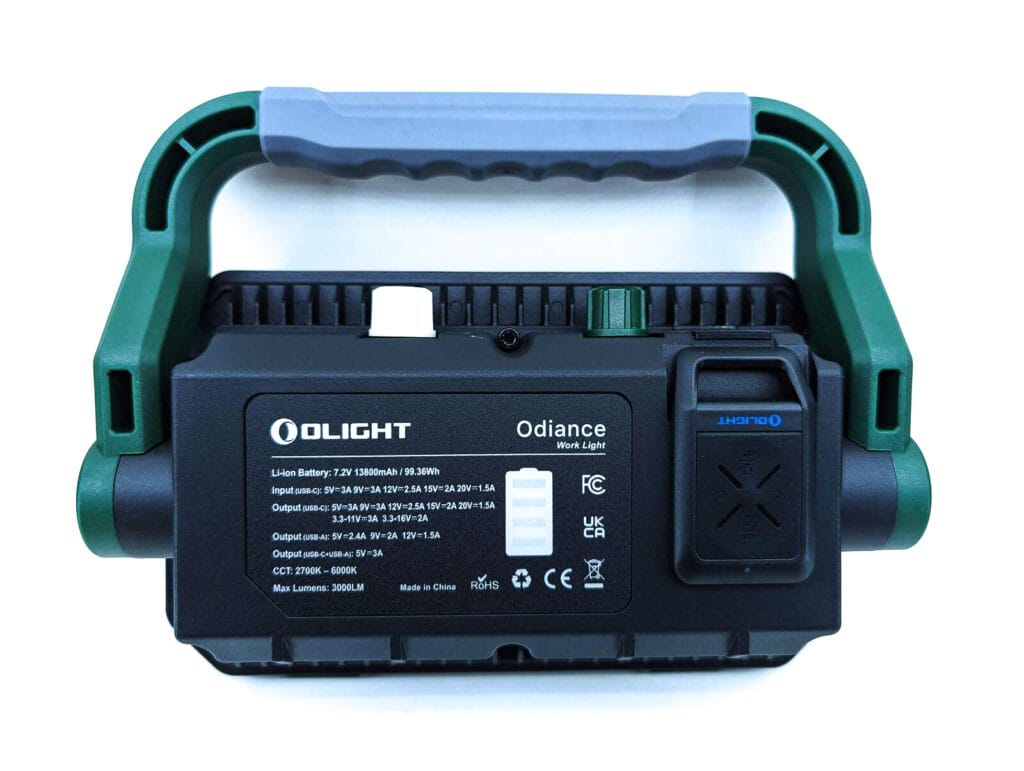
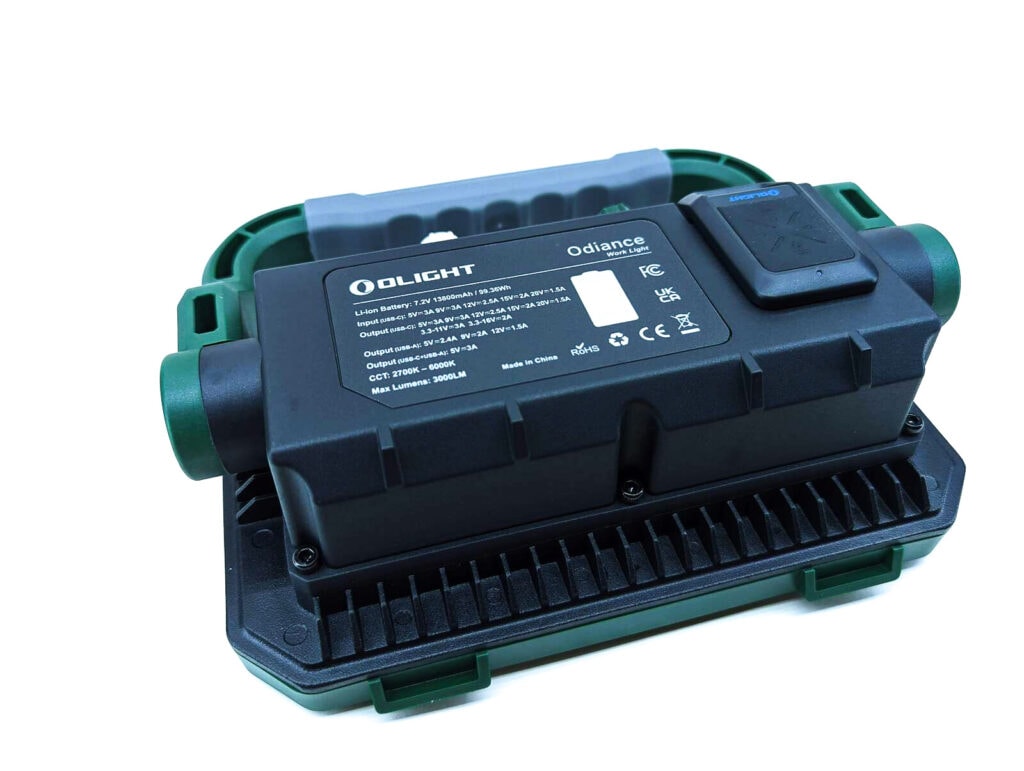
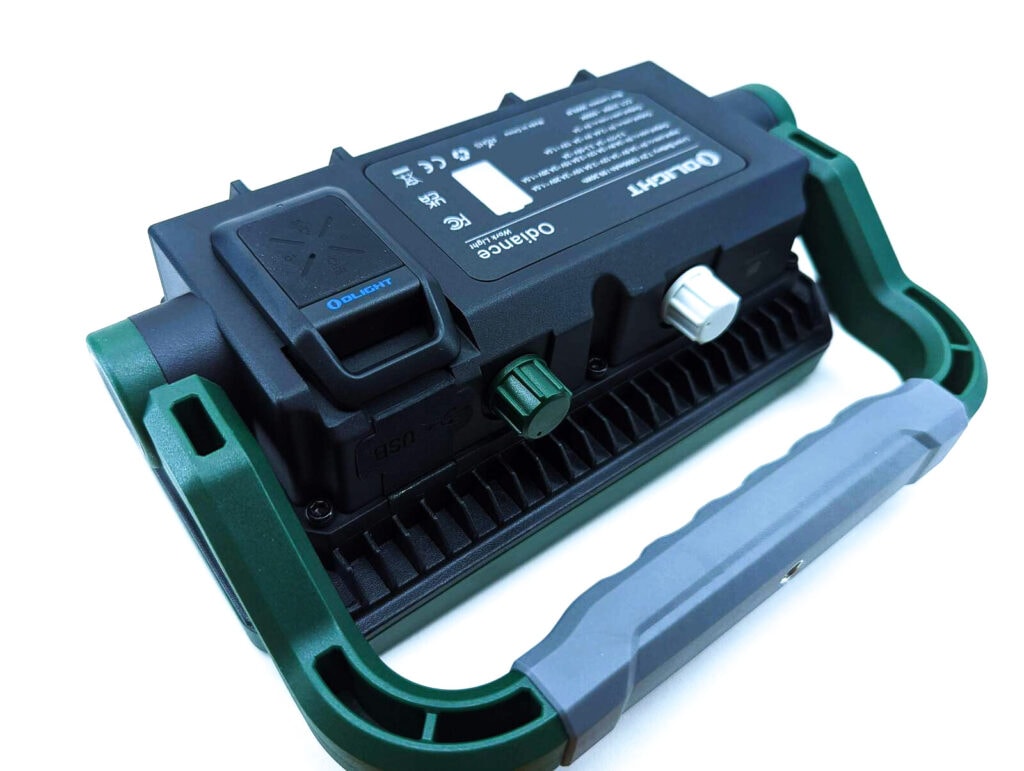
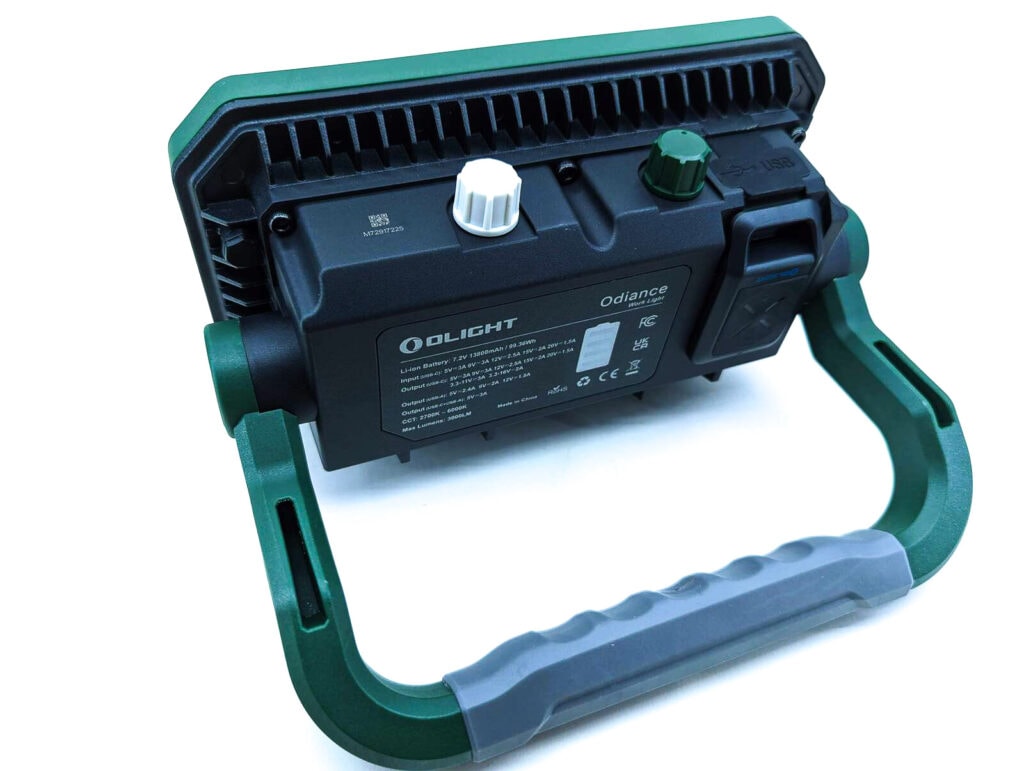
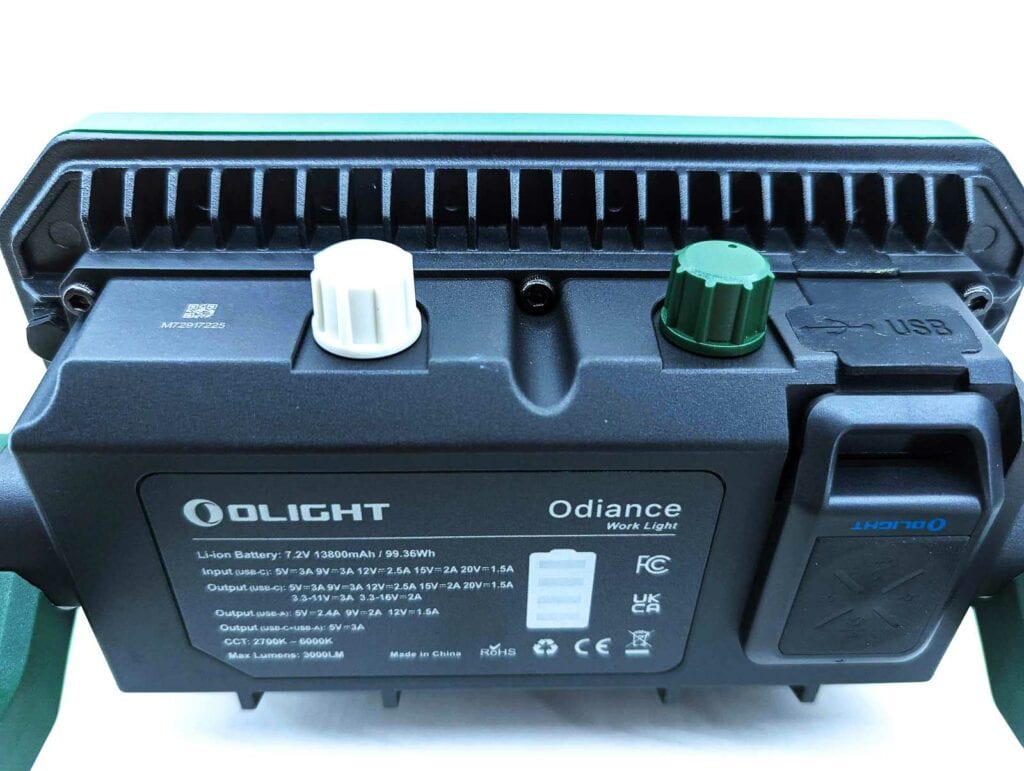
LED, Lens, Bezel, Beam, and Reflector
The front of the Olight Odiance is mostly taken up by one huge COB LED. COB is protected by a lens, then a steel cage over top of that to help address impacts. The COB has alternating columns of warm white and cool white elements. According to Olight, there’s a CCT range between 2700K and 6000K. The large, broad emitter produces a super-floody light that’s great at illuminating large areas. I took the following measurements with my Opple Light Master at 1 meter:
Warm White setting:
- CCT: 3219K
- CRI: 84.3 Ra
- DUV: +0.0005
Cool White setting:
- CCT: 6305K
- CRI: 84.8 Ra
- DUV: -0.0002
In-between the warm and cool settings:
- CCT: 4124K
- CRI: 87.0 Ra
- DUV: -0.0064
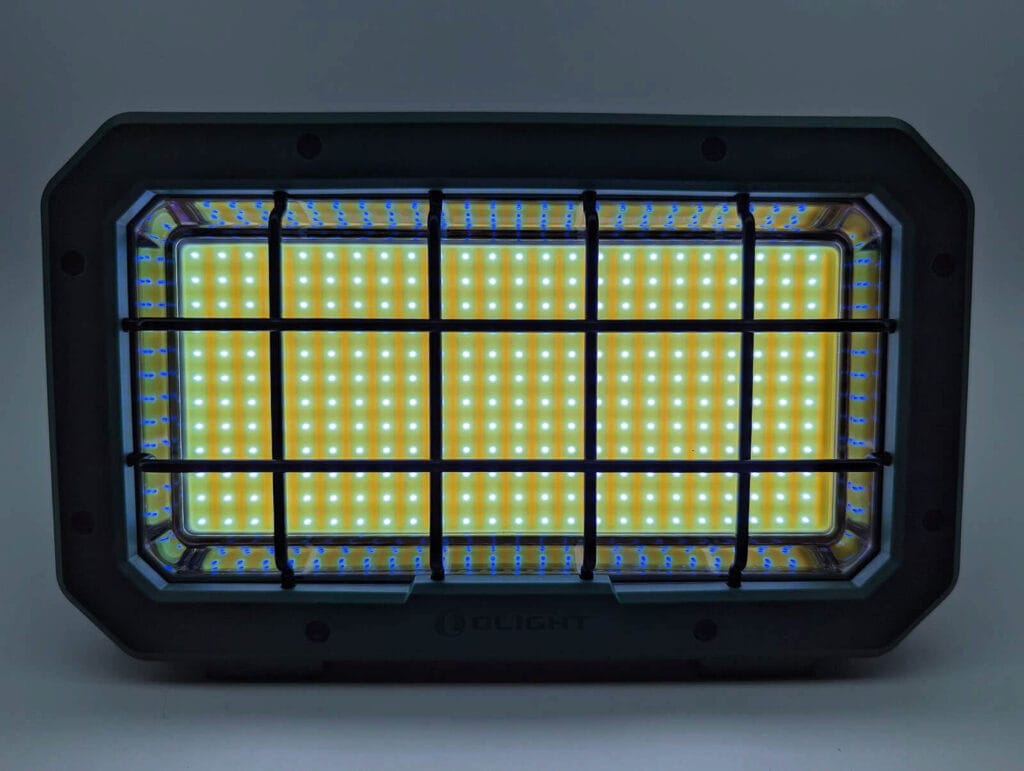
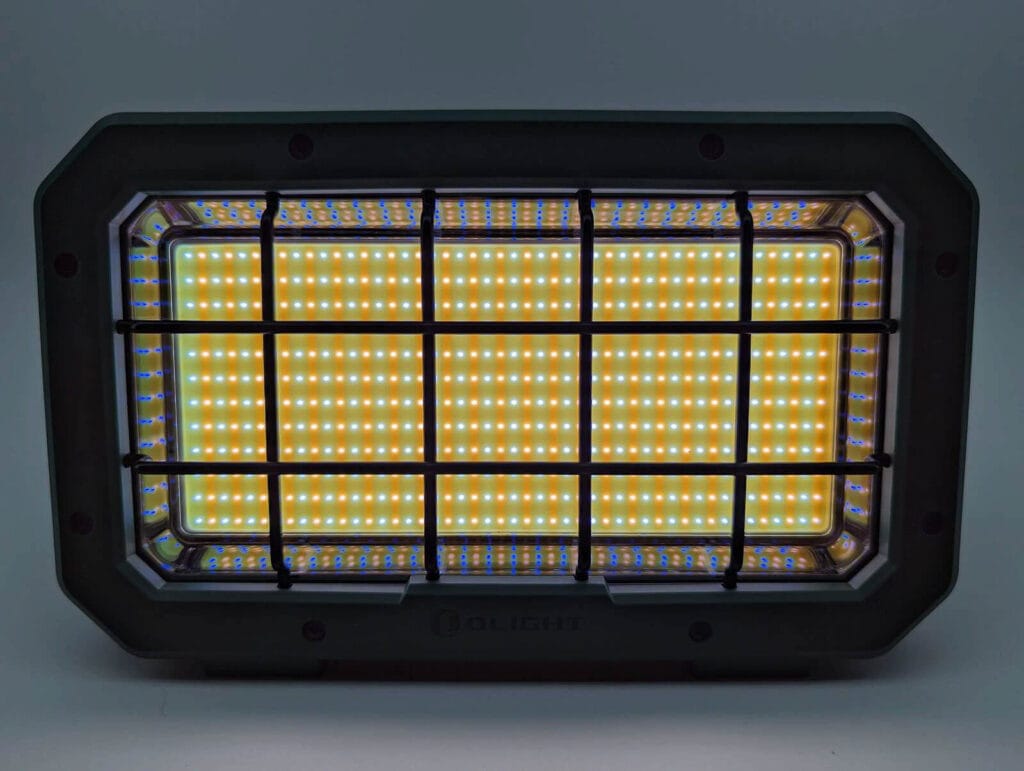
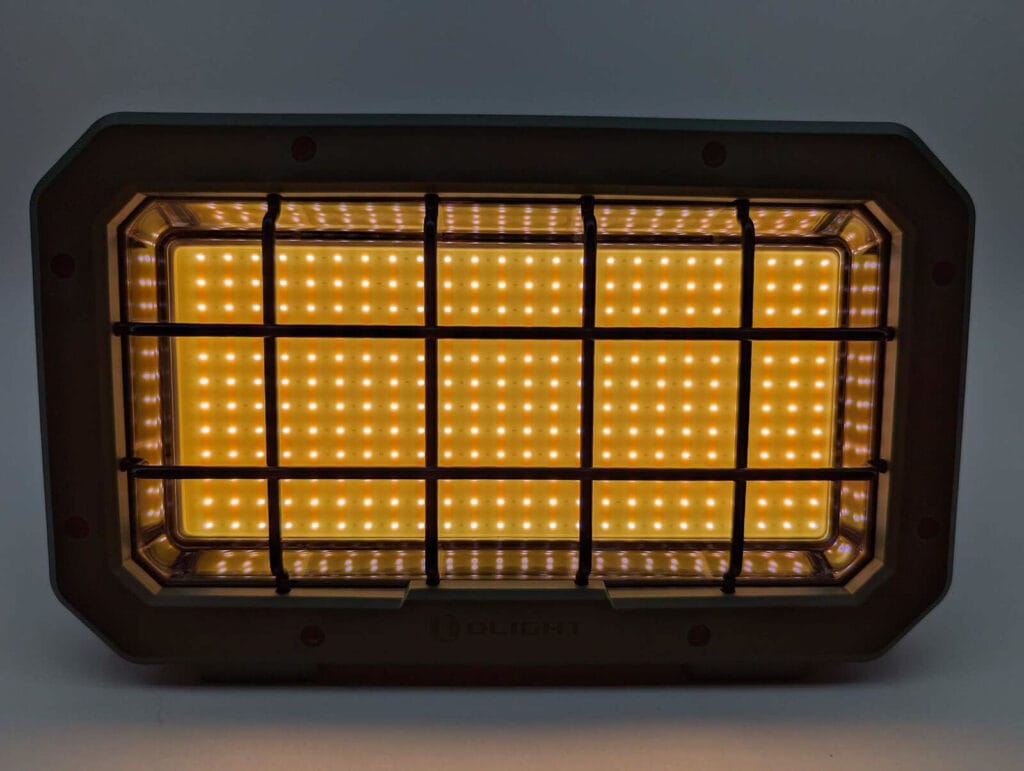
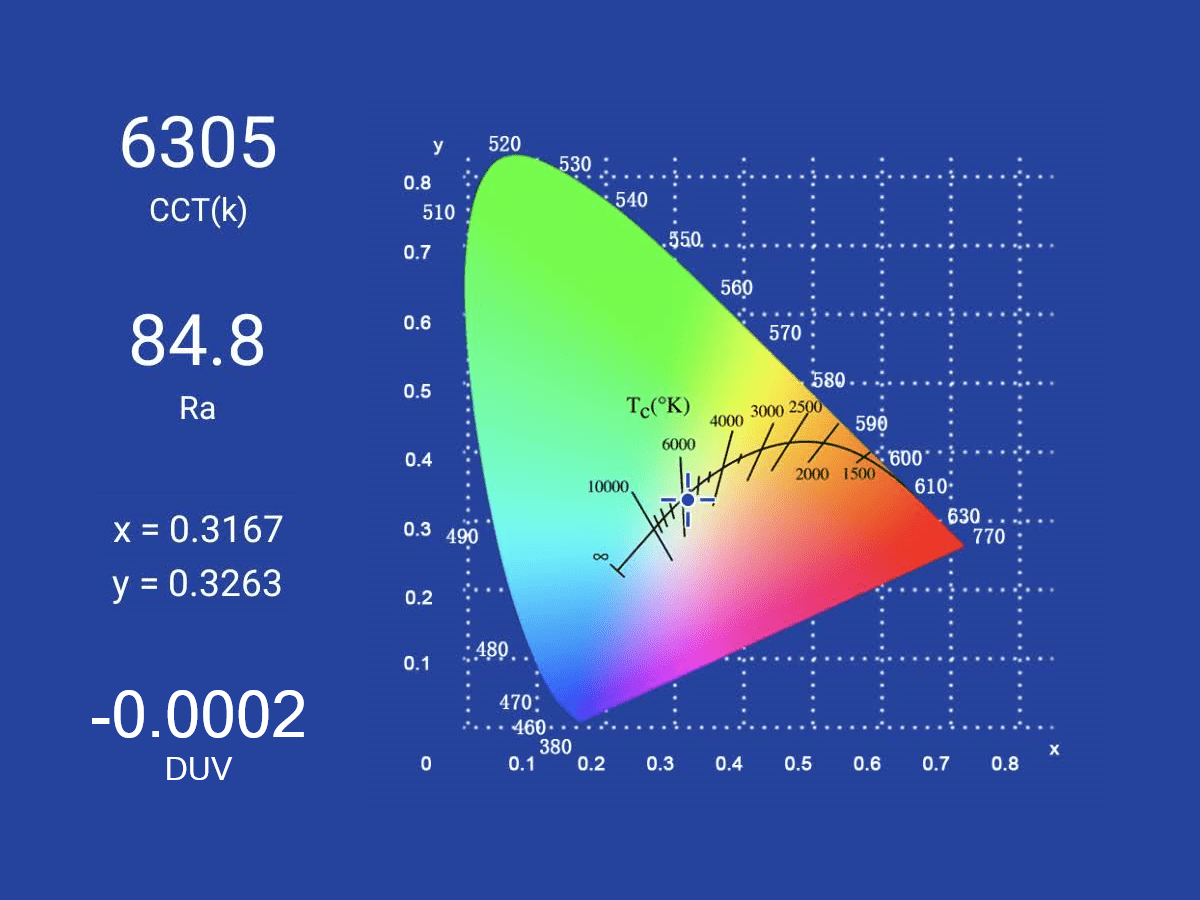
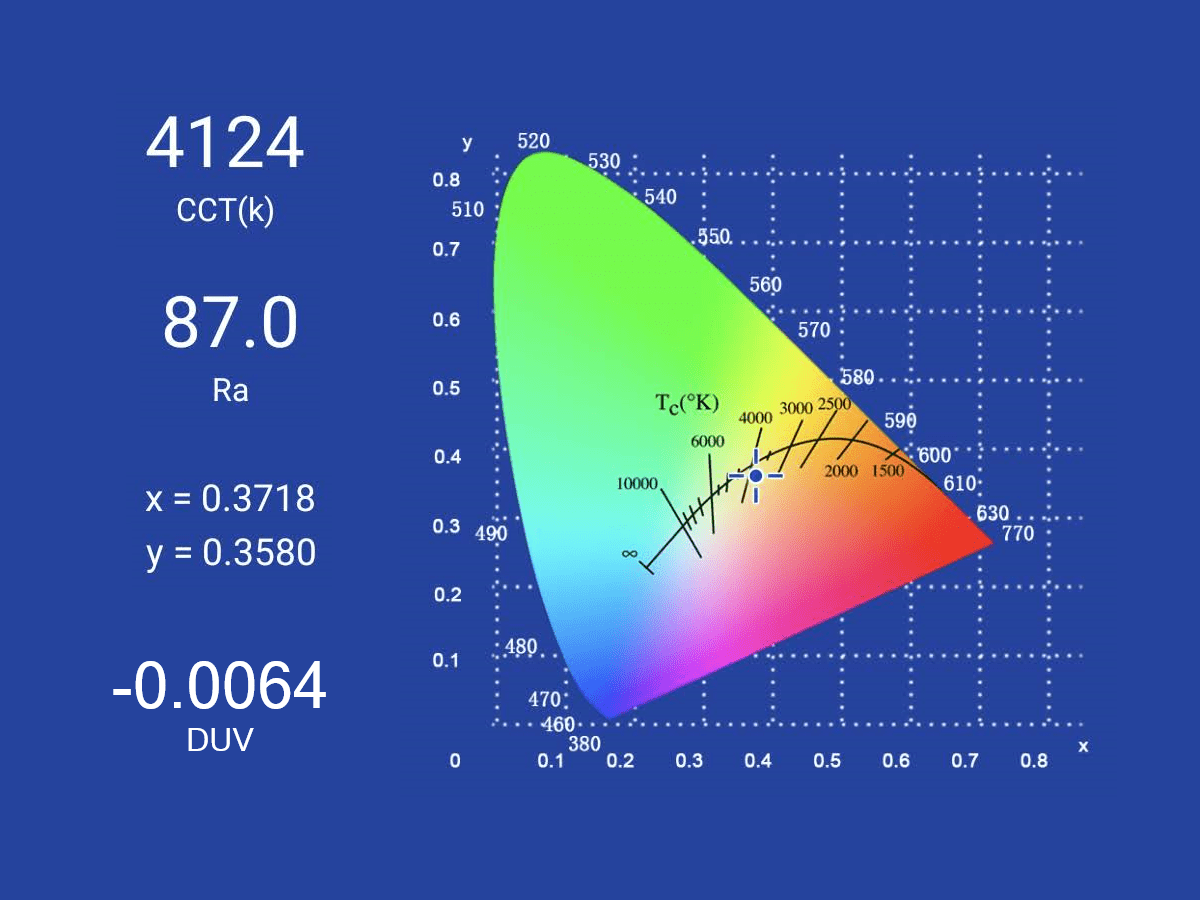
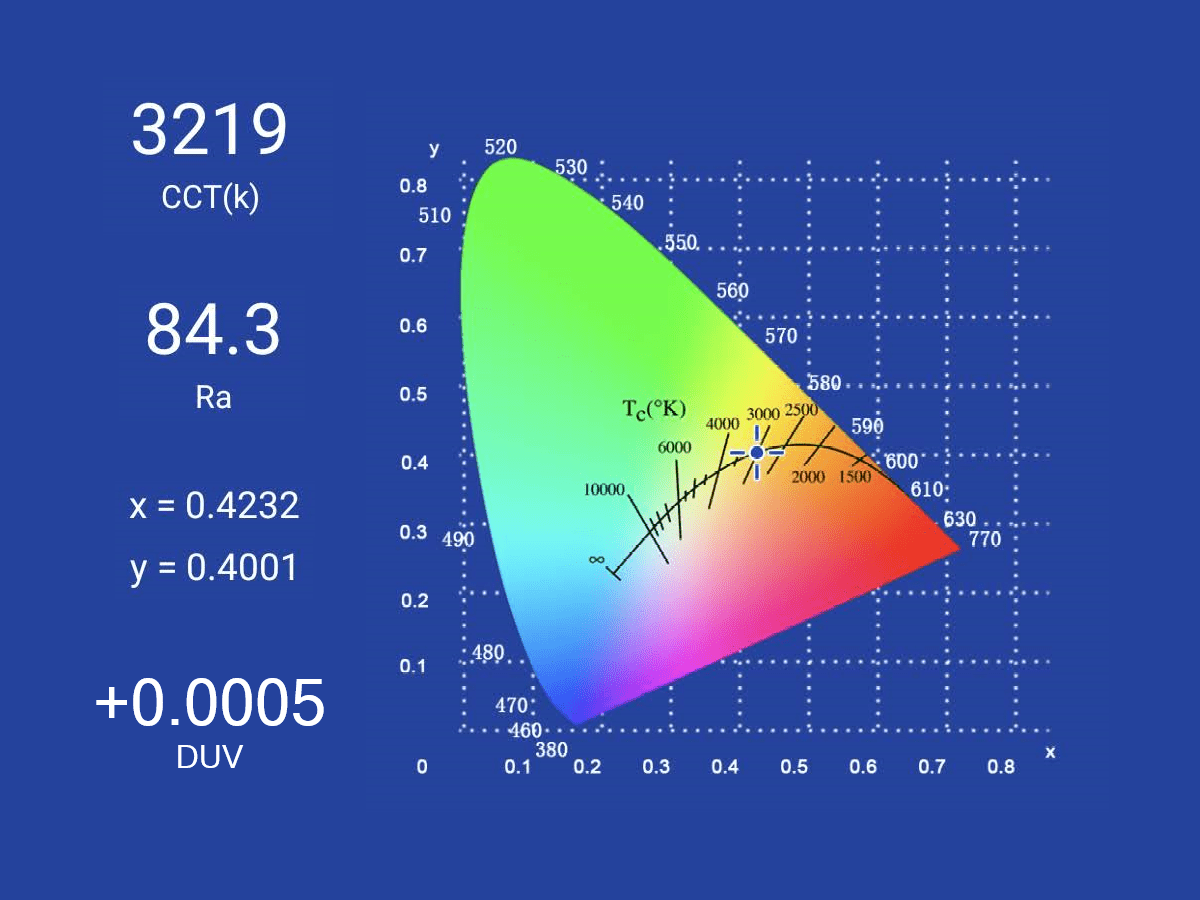
Dimensions and size comparison
Dimensions:
| Olight Odiance Dimension | Millimeters | Inches |
|---|---|---|
| Length | 222 | 8.74 |
| Width | 76 | 2.99 |
| Height | 188 | 7.4 |
Weight:
| Olight Odiance Weight | Grams | Oz. |
|---|---|---|
| With battery | 1670 grams | 58.9 |
Flashlight size comparison with its competition
Group 1: Smart Electrician work light (large), Olight Odiance, Smart Electrician work light (small)
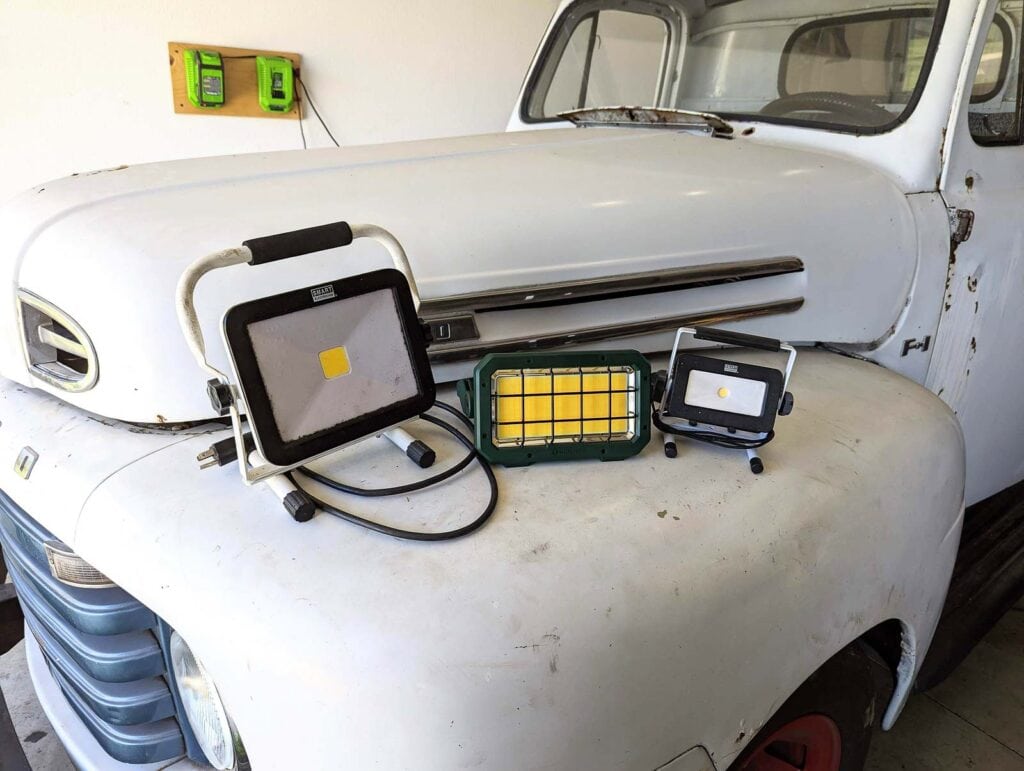
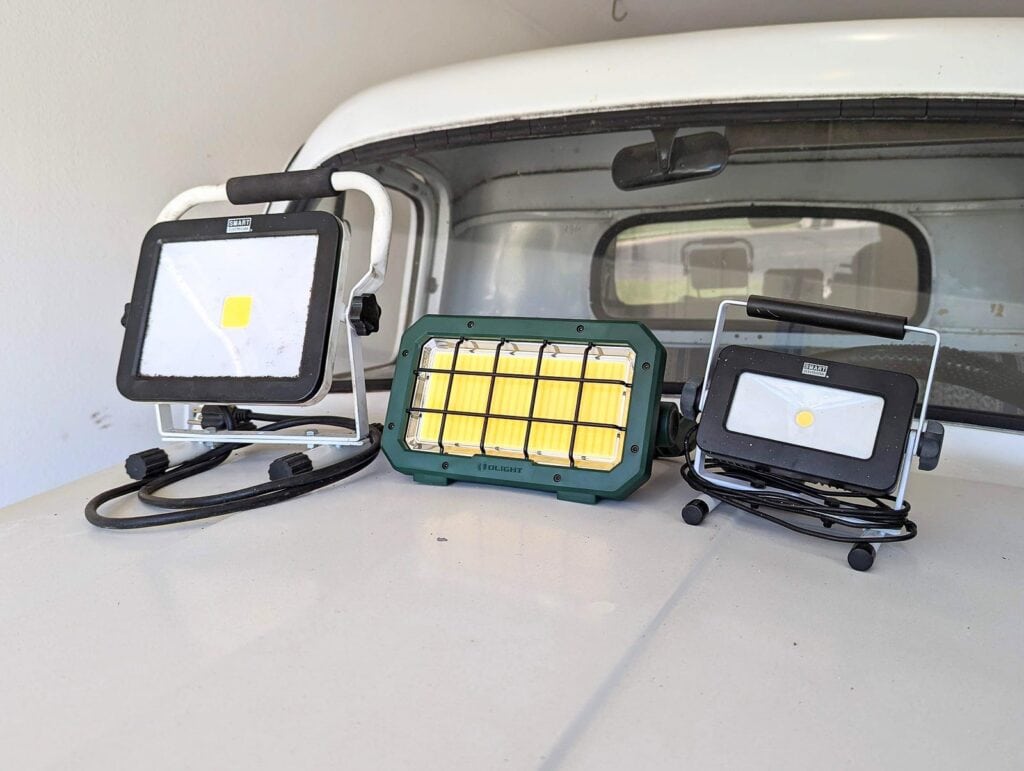
Driver & User Interface:
Aside from the remote control, operating the Olight Odiance is about as easy as it gets. One knob to control on/off and brightness, the other to control CCT.
Available modes: N/A (stepless dimming)
Available blinky modes: none
User interface:
From OFF:
- Rotate Power knob clockwise: turn on
From ON:
- Further clockwise rotation of Power knob: increase brightness
- Counterclockwise rotation of Power knob: decrease brightness
- Counterclockwise rotation of Power knob until it clicks: turn off
- Clockwise rotation of the Color Temp knob: decrease the color temperature
- Counterclockwise rotation of the Color Temp knob: increase the color temperature
Remote Control:
- “On button”: Single press to turn the light on or increase the brightness by one level (10 levels available
- “On” button”: Long press for 1 second to access the brightest setting directly
- “Off” button”: Single press to turn the light off or decrease the brightness by one level (10 levels available)
- “Off button”: Long press for 1 second to turn it off directly
- “C+” button: While the light is on, single press to increase the color temperature by one level (10 levels available) until it reaches 6,000K
- “C+” button: Long press for 1 second to reach 6,000K directly
- “C-” button: While the light is on, single press to decrease the color temperature by one level (10 levels available) until it reaches 2,700K
- “C-” button: Long press for 1 second to reach 2,700K directly
Mode memory:
- Color Temp will be memorized
Shortcuts:
- N/A
Low voltage warning:
- There is a 4-bar battery level indicator on the back of the Odiance
Strobe/blinkies
- None
Lock-out mode:
- None
PWM
- Not preset
Batteries & Charging
The Odiance has a beefy built-in battery that is not user-accessible. It looks like if your battery wears out and you’re outside of the warranty period, you might be able to remove the rear cover and figure something out. I wouldn’t recommend it though, and it would assuredly void your warranty. The built-in battery is 99.36 watt-hours (7.2V / 13,800 mAh). It charges via a USB-C port that’s located under a dust plug on the top/rear. The dust plug is very thick and seems like it seals the ports off very well. Olight claims that the unit will charge in 5.5 hours when using a 30W PD Fast charger. I used a 33W PD charger and it worked great, but unfortunately I couldn’t measure the charge time because my USB meter doesn’t do well with devices that are capable of reverse charging.
That’s another interesting point – the USB-C port can also serve as a power bank. Plugging my phone (Pixel 6) into it resulted in a “charging rapidly” message, which is indicative of PD fast charging. Oh, and in addition to the USB-C port, there’s also a full USB-A port under the dust plug that can be used for power bank functionality.
The back of the Odiance lists out a lot of charging and reverse charging capabilities:
- Input (USB-C): 5V 3A, 9V 3A, 12V 2.5A, 15V 2A, and 20V 1.5A
- Output (USB-C): 5V 3A, 9V 3A, 12V 2.5A, 15V 2A, 20V 1.5A, 3.3-11V 3A, and 3.3-16V 2A
- Output (USB-A): 5V 2.4A, 9V 2A, 12V 1.5A
- Output (USB-C + USB-A): 5V 3A
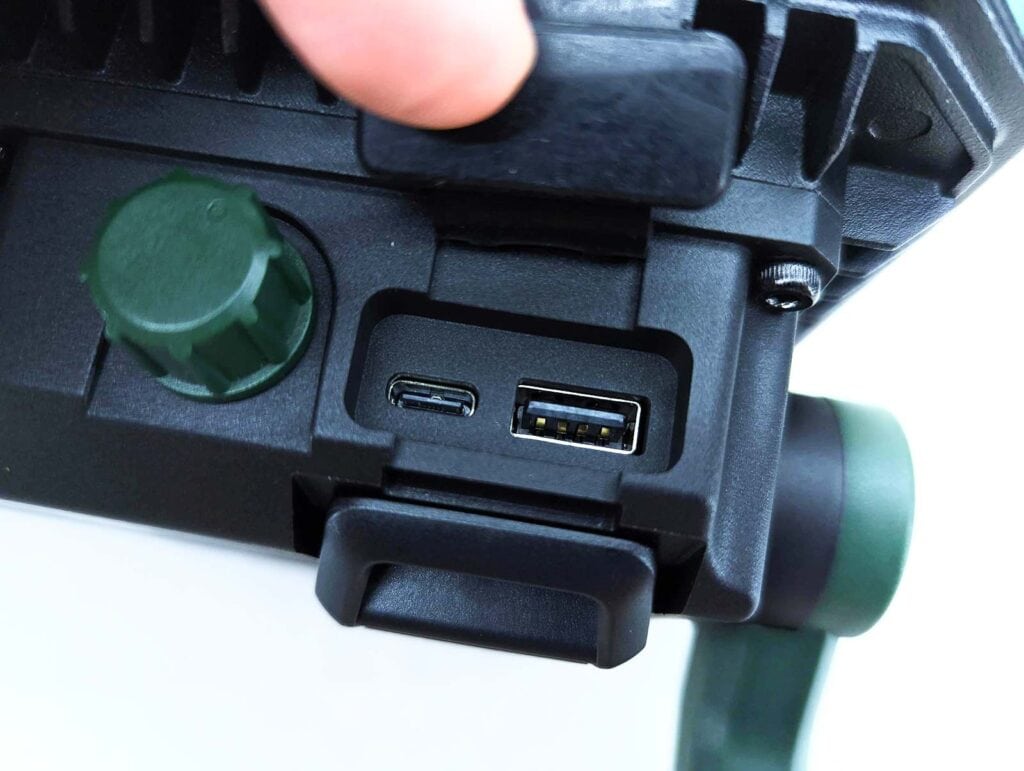
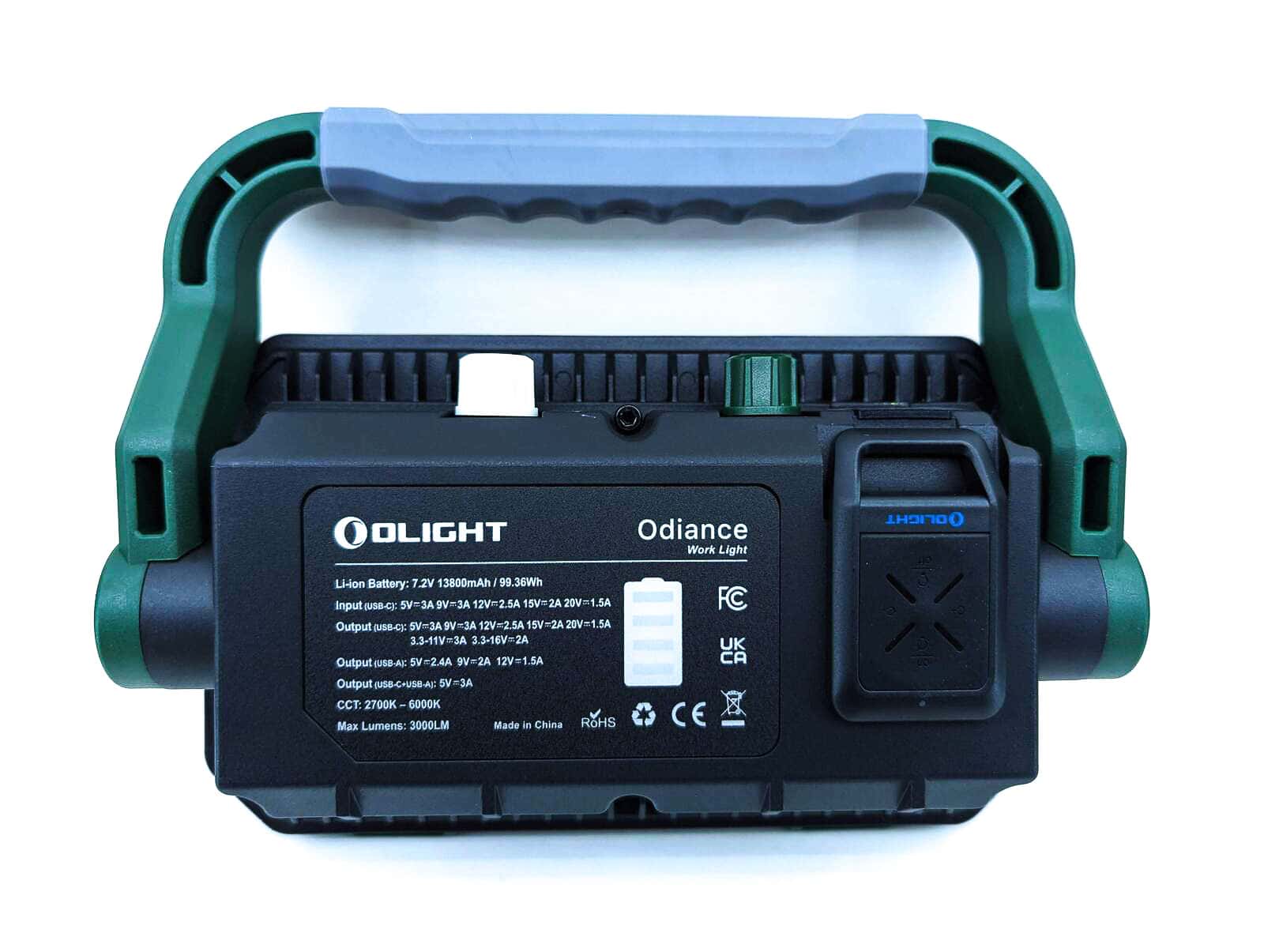
Performance test
Lumen measurements
I typically measure lumens with my lumen tube that has been calibrated with a Maukka light. But due to the massive emitting area of the Odiance, it wouldn’t fit in my tube. It would take a large tube (or sphere even) to handle that large COB. So I switched over to using the Ceiling Bounce app in a small white room. I attempted to calibrate the app using values of multiple lights that I tested in the lumen tube, and then moved over to the small white room. I would call the values very close, and considering that they line up well with Olight’s claim, I think they’re a good representation.
The Odiance steps down a couple of times throughout the runtime. Olight calls these out very clearly on the specs table.
Since the Odiance has stepless dimming, it’s difficult to report on much besides the top and bottom of the ramp. I did run a test that was about mid-way into the ramp, on CW, just to see how it would perform. I’ve included those figures as well.
| Mode | Specs | turn on | 30 sec | 10 minutes |
|---|---|---|---|---|
| Low, CW | 230 lm | 218 lm | 218 lm | – |
| High, CW | 3000 > 1500 > 900 lm | 2924 lm | 2924 lm | 2870 lm |
| Low, WW | 200 lm | 177 lm | 177 lm | – |
| High, WW | 2500 > 1250 > 750 lm | 2462 lm | 2407 lm | 2353 lm |
| Middle, CW | – | 1701 lm | 1701 lm | 1688 lm |
Parasitic drain:
- unable to test due to built-in battery design
Battery Life: Runtime graphs
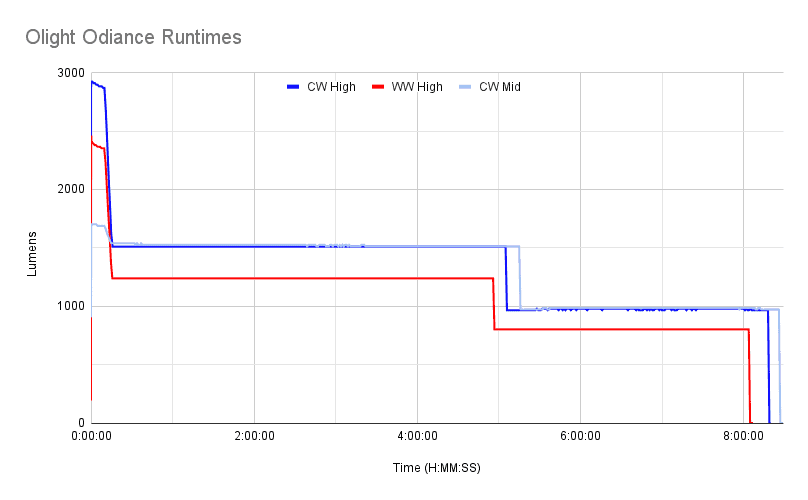
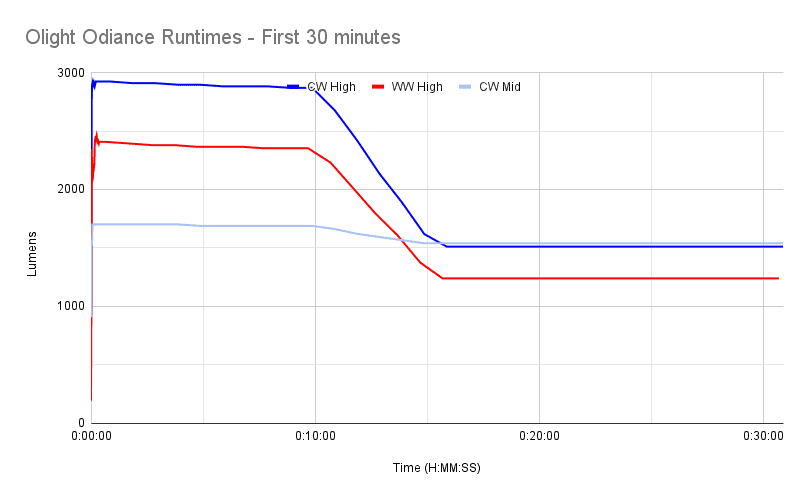
| Mode | Specified | Measured runtime (ANSI) | Time till shut off |
|---|---|---|---|
| Low, CW | 2800 min (46.67 hr) | – | – |
| High, CW | 15+280+180 min | 8 hr 18 min | 8 hr 18 min |
| Low, WW | 2800 min (46.67 hr) | – | – |
| High, WW | 15+280+180 min | 8 hr 4 min | 8 hr 4 min |
| Middle, CW | – | 8 hr 26 min | 8 hr 26 min |
The runtimes on High follow right at what Olight said to expect. Please excuse me for not doing full runtime tests on the low modes – 2 days (each) is a long time to be running tests for!
ANSI FL1 standards: The runtime is measured until the light drops to 10% of its initial output (30 seconds after turning on). This does not mean that the flashlight is not usable anymore. The last column shows how long the light actually works till it shuts off. If there is a + symbol, it means that the test was stopped at that particular point, but the light was actually still running. This happens on certain occasions, with certain drivers, firmware, or batteries.
Peak beam intensity and beam distance measurements
Lux was measured by a UNI-T UT383 BT at 5 meters
| Mode | Specs | Candela measured | Meters | Yards |
|---|---|---|---|---|
| High, CW | 1500 cd | 2150 cd | 93 | 101 |
| High, WW | – | 1700 cd | 82 | 90 |
Olight provided just a single intensity spec (1500 cd / 75 m) which I’ll just assume is for the CW mode.
Extra info: Peak beam distance according to ANSI FL1 standards: The calculated value of distance in meters at which the flashlight produces a light intensity of 0.25 lux. (0.25 lux is about the brightness of a full moon shining on an object).
Beamshots
Beam shots of the building are taken at 15 m (16 yd) using a Pixel 6 set to ISO 200 with 1/10 second exposure time
Beam shots of the playset are taken at 30 m (33 yd) using a Pixel 6 set to ISO 200 with 1/2 second exposure time. The trees in the background are around 65 m away.
Beamshots compared to the following flashlights:
- Olight Odiance, CW
- Olight Odiance, WW
- Smart Electrician work light (large, corded)
- Smart Electrician work light (small, corded)
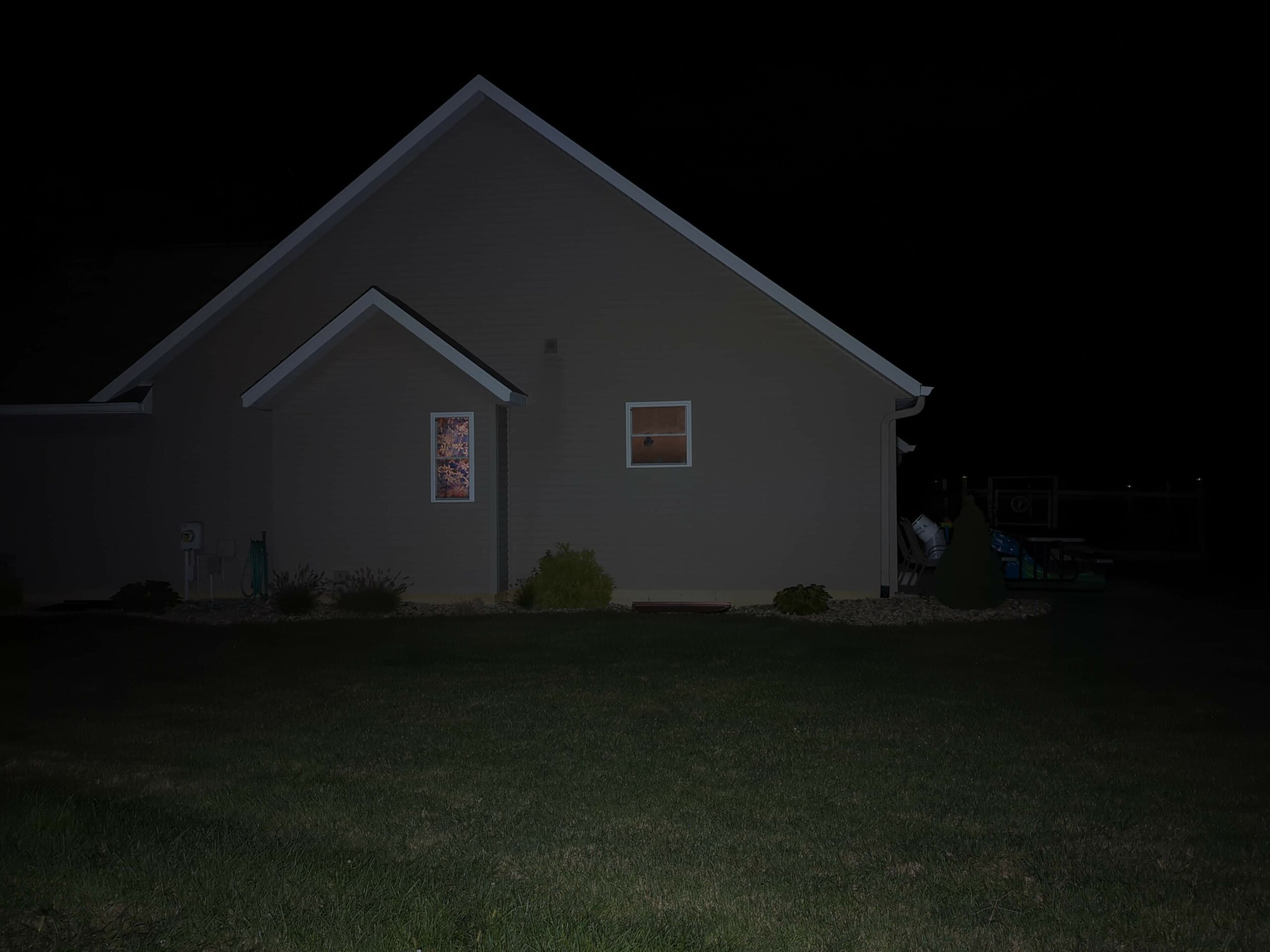
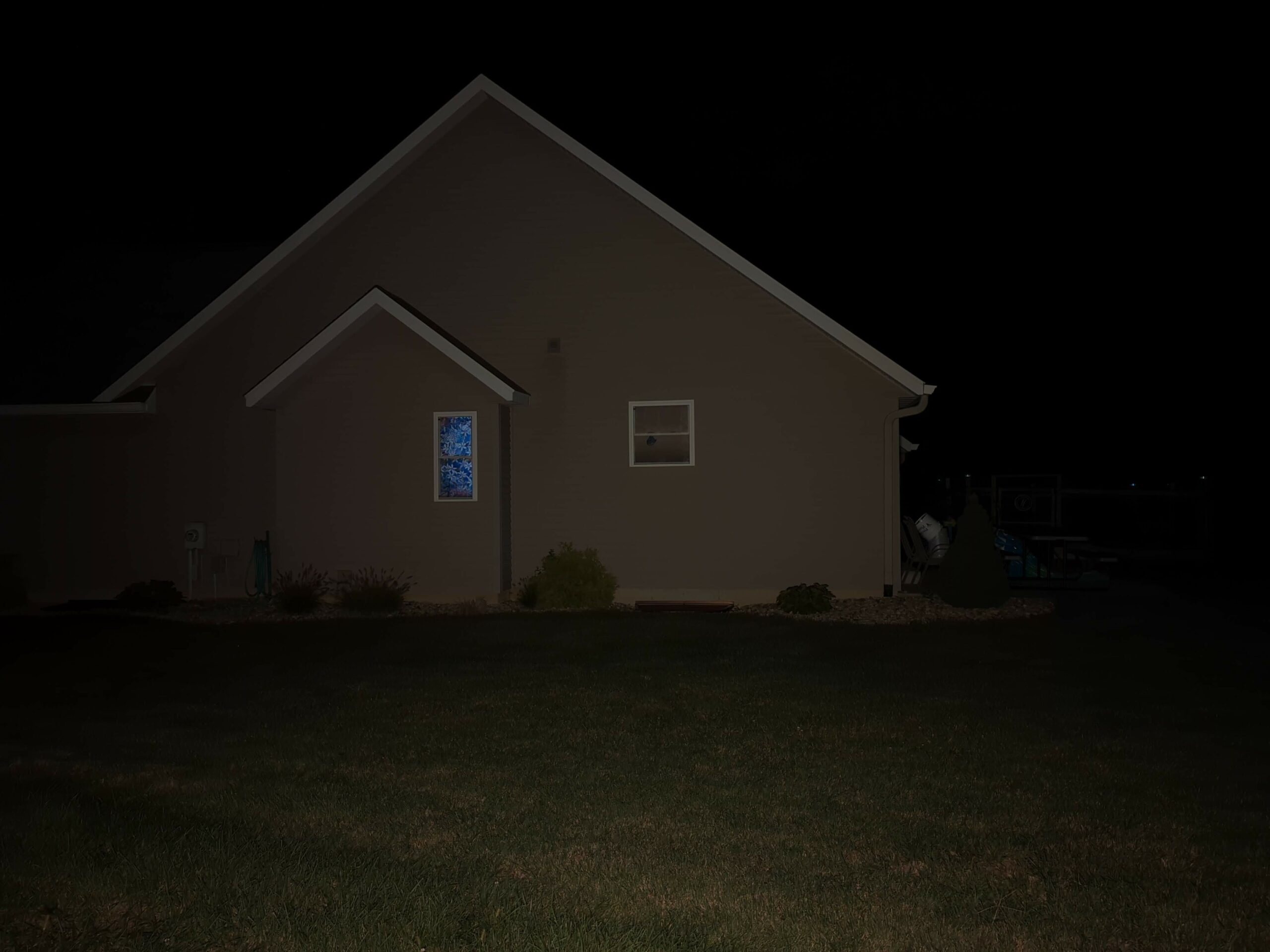
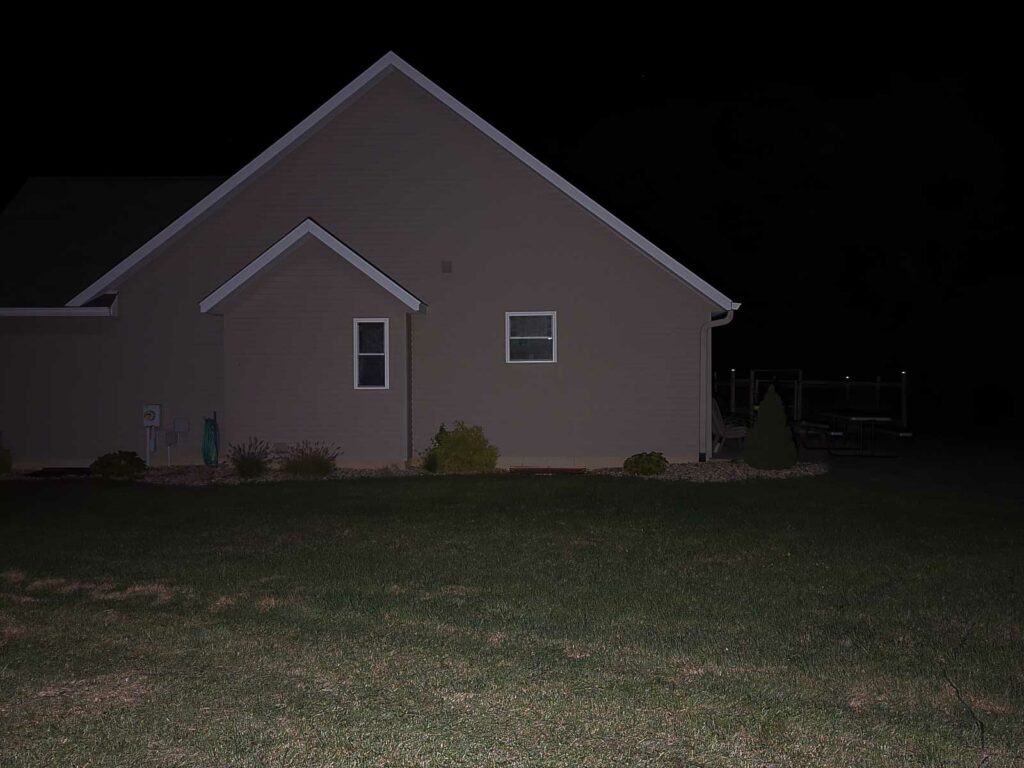
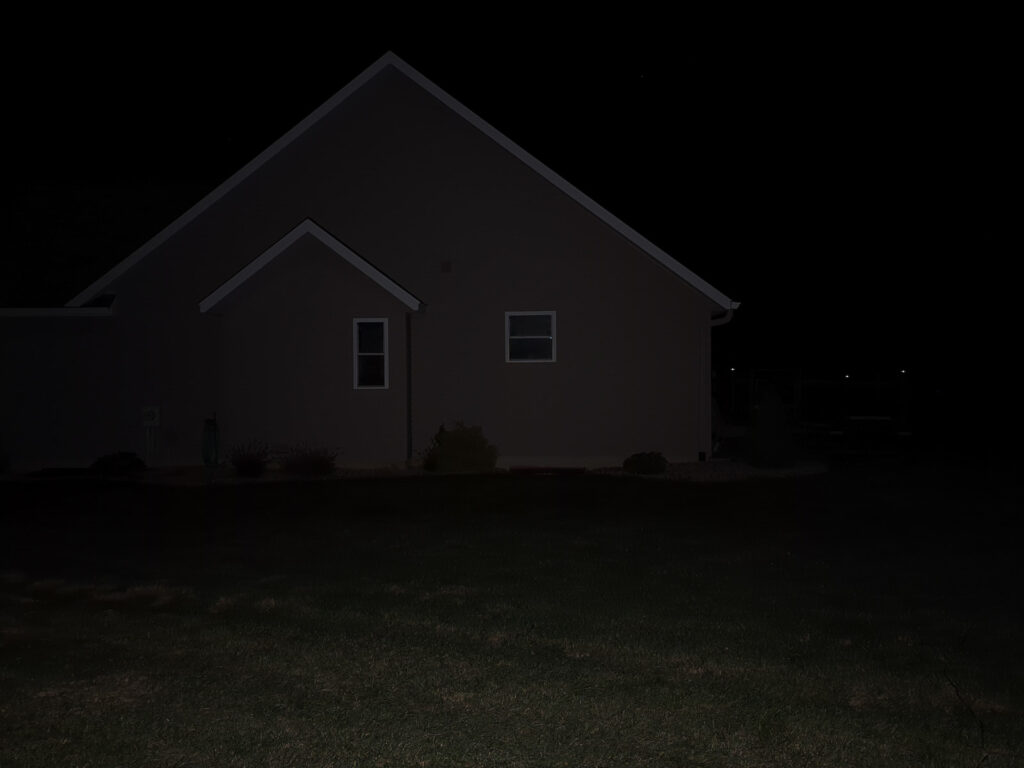
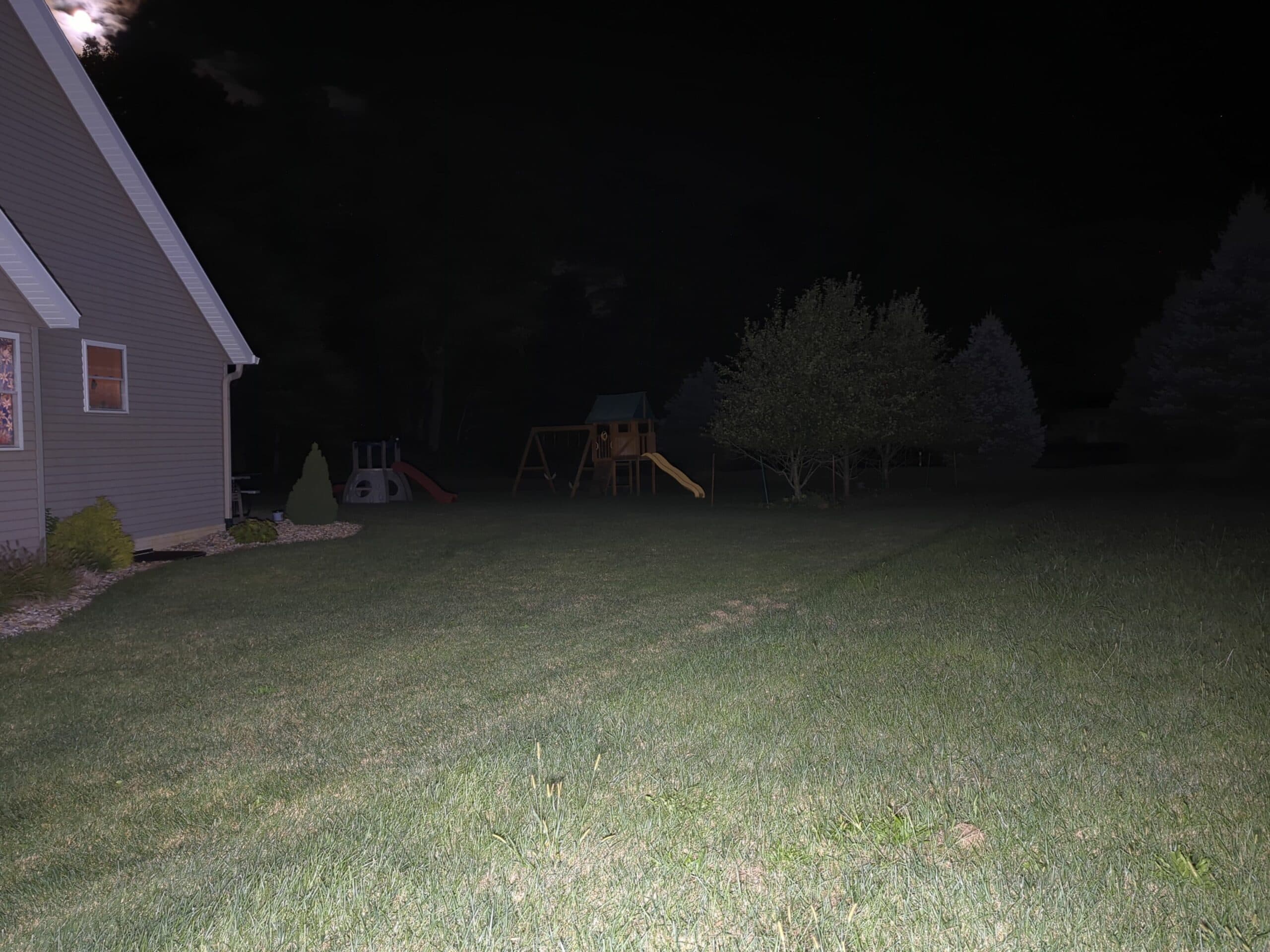
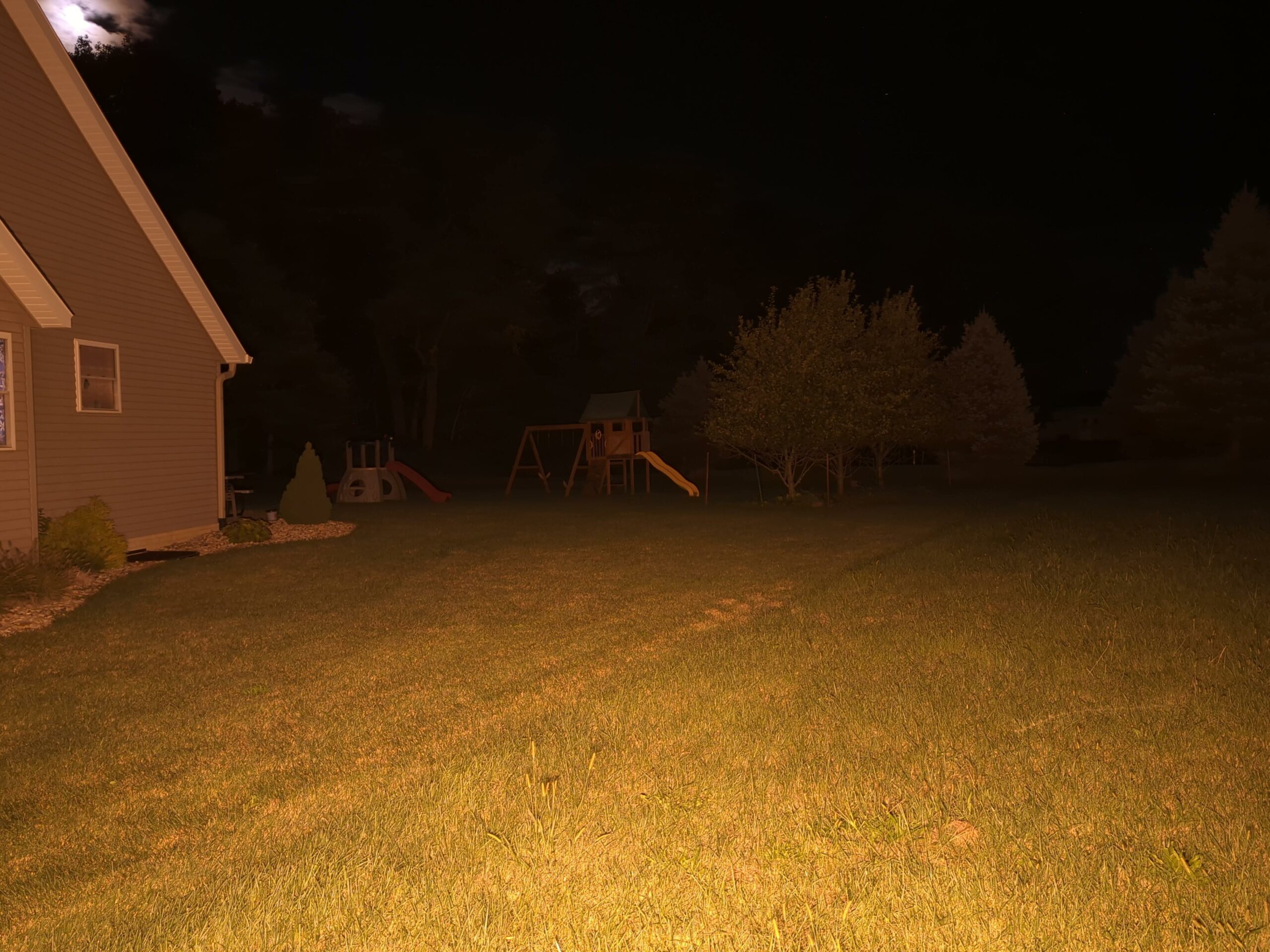
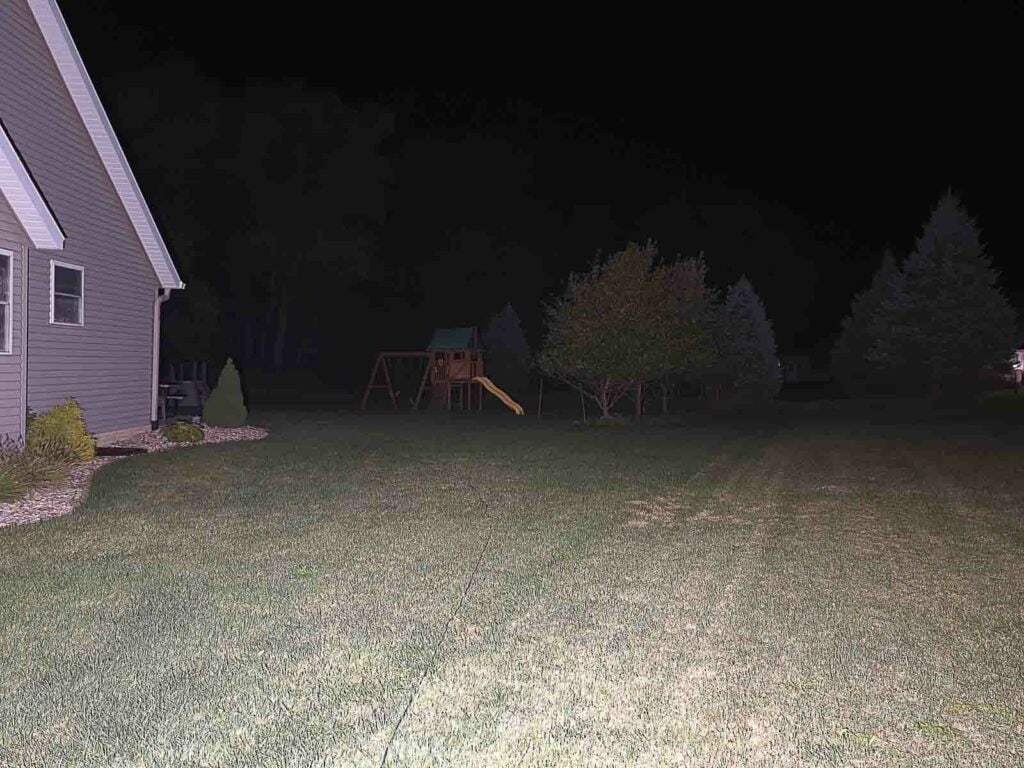
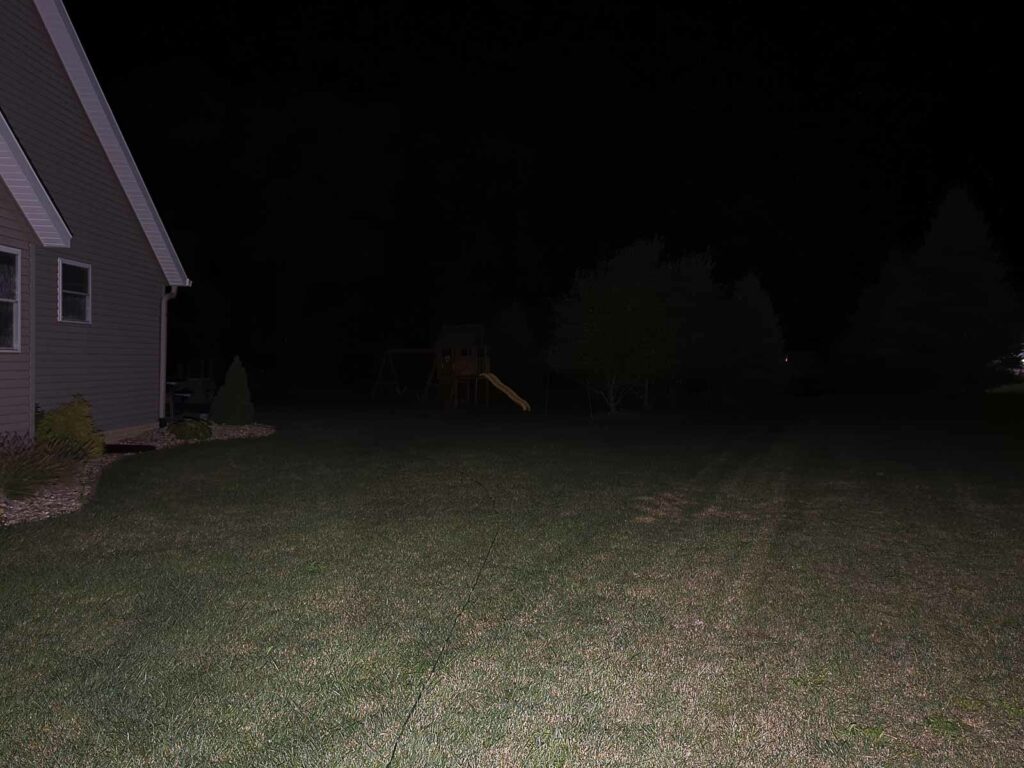
Disclaimer: This flashlight was sent to me for review at no cost by Olight. I have not been paid to review, nor have I been holding back on problems or defects.
Final Verdict
Pros
- Long running
- Stable output
- Variable CCT
- Stepless dimming
- USB-C charging
- Power bank functionality
- Remote control
Cons
- Non-serviceable battery
Explanation on star ratings:
1: Avoid: a match would be a better choice – 2: Poor: significant defect or issues; almost unusable – 3: Average: some defects or issues; but still usable 4: Good: recommended (minor issues) – 5: Great: highly recommended

5 stars: ★★★★★
There are a lot of times when a bright, floody light can be handy – in the garage working on a car, lighting up that backyard party, or providing some gentle illumination for your campsite. These tasks generally call for different types of light though; I like a bright cool (or neutral) light for working on my vehicles, a very low and warm light for camping, and somewhere in between for backyard activities. With its easy adjustment knobs for both Color Temperature and Brightness, the Olight Odiance covers these very different lighting scenarios. There’s a lot of other stuff to love about it too: remote control, the USB charging and power bank, and stable output that can last for nearly 2 days. Oh, and those old corded work lights I have in the garage? History.
Olight Odiance discount coupon code
Use our exclusive 1lumen discount code to get an extra 10% off anything you order at Olightstore.com (USA). Coupon code: 1lumen
1lumen selects and reviews products personally. We may earn affiliate commissions through our links, which help support our testing.
